User Manual

UltraLine II VDSL Gateway – Draft 1
030-300237 Rev. A
8/8/06
Copyright © 2006 Westell, Inc. 030-300237 Rev. A
ULTRALINE II VDSL GATEWAY (MODEL 826010)
USER GUIDE

UltraLine II VDSL – Draft 1
030-300237 Rev. A
8/8/06
030-300237 Rev. A 2 August 2006
User Guide UltraLine II VDSL Gateway (Model 826010)
TABLE OF CONTENTS
1. PRODUCT DESCRIPTION ..................................................................................................................................4
2. SAFETY INSTRUCTIONS ...................................................................................................................................4
3. REGULATORY INFORMATION ........................................................................................................................5
3.1 FCC Compliance Note...............................................................................................................................5
3.2 Canada Certification Notice.......................................................................................................................6
4. NETWORKING REQUIREMENTS .....................................................................................................................7
5. HARDWARE FEATURES....................................................................................................................................8
5.1 LED Indicators...........................................................................................................................................8
5.2 Cable Connectors and Switch Locations....................................................................................................9
5.3 Connector Descriptions..............................................................................................................................9
6. INSTALLING THE HARDWARE......................................................................................................................10
6.1 Installation Requirements ........................................................................................................................10
6.2 Before you begin......................................................................................................................................10
6.3 Microfilters ..............................................................................................................................................10
6.4 Hardware Installations .............................................................................................................................11
6.4.1 Installation via Ethernet ...........................................................................................................................11
6.4.2 Connecting PCs via Wireless...................................................................................................................12
7. SETTING UP Macintosh OS X............................................................................................................................13
7.1 Opening the System Preference Screen ...................................................................................................13
7.2 Choosing the Network Preferences..........................................................................................................13
7.3 Creating a New Location .........................................................................................................................14
7.4 Naming the New Location .......................................................................................................................14
7.5 Selecting the Ethernet Configuration.......................................................................................................15
7.6 Checking the IP Connection ....................................................................................................................15
7.7 Accessing the Gateway’s User Interface..................................................................................................16
8. CONFIGURING YOUR GATEWAY FOR INTERNET CONNECTION .........................................................17
8.1 Accessing your VDSL Gateway ..............................................................................................................17
8.2 Confirming Your VDSL Sync .................................................................................................................18
8.3 Setting Up Your Connection Profile........................................................................................................19
8.4 Establishing a WAN Connection .............................................................................................................22
8.5 Disconnecting Your WAN Connection ...................................................................................................25
9. BASIC MODE .....................................................................................................................................................26
10. HOME ..................................................................................................................................................................27
10.1 Connection ...............................................................................................................................................27
10.2 Connection Summary...............................................................................................................................28
11. STATUS...............................................................................................................................................................29
11.1 About .......................................................................................................................................................29
11.2 LAN Devices ...........................................................................................................................................30
11.3 Wireless Stations......................................................................................................................................31
12. DIAGNOSTICS ...................................................................................................................................................32
13. RESTART ............................................................................................................................................................35
14. ADVANCED MODE...........................................................................................................................................37
15. CONFIGURATION .............................................................................................................................................38
15.1 Firewall Configuration.............................................................................................................................38

UltraLine II VDSL – Draft 1
030-300237 Rev. A
8/8/06
030-300237 Rev. A 3 August 2006
User Guide UltraLine II VDSL Gateway (Model 826010)
15.2 Port Forwarding Configuration................................................................................................................39
15.3 Port Triggering Configuration .................................................................................................................44
15.4 ALG Configuration..................................................................................................................................45
15.5 IGMP Service ..........................................................................................................................................47
15.6 LAN Configuration..................................................................................................................................49
15.6.1 DHCP for Private LAN............................................................................................................................49
15.6.2 DNS .........................................................................................................................................................51
15.6.3 Public LAN—Multiple IP Address Passthrough .....................................................................................53
15.6.4 IP Passthrough—Single IP Address Passthrough ....................................................................................55
15.6.5 Static NAT ...............................................................................................................................................59
15.6.6 Port Mapping ...........................................................................................................................................61
15.7 Spanning Tree ..........................................................................................................................................62
15.8 WAN Configuration.................................................................................................................................63
15.8.1 VDSLATM ..............................................................................................................................................63
15.8.2 VCs ..........................................................................................................................................................64
15.8.3 QOS .........................................................................................................................................................69
15.8.4 VPN .........................................................................................................................................................73
15.8.5 Routing Table ..........................................................................................................................................74
15.9 Wireless Configuration ............................................................................................................................76
15.9.1 Basic ........................................................................................................................................................76
15.9.2 Wireless Security .....................................................................................................................................78
15.9.3 MAC Filter...............................................................................................................................................83
15.9.4 Advanced Wireless Settings ....................................................................................................................86
16. MAINTENANCE.................................................................................................................................................87
16.1 Login Administration...............................................................................................................................87
16.2 Backup/Restore........................................................................................................................................88
16.3 Event Log.................................................................................................................................................89
16.4 Firewall Log.............................................................................................................................................92
16.5 Update Device..........................................................................................................................................93
16.6 Statistics ...................................................................................................................................................94
16.6.1 Ethernet Statistics ....................................................................................................................................94
16.6.2 Switch Ports Statistics..............................................................................................................................95
16.6.3 VDSL Device Info. ..................................................................................................................................96
16.6.4 VDSL Traffic Statistics............................................................................................................................97
16.6.5 ATM Statistics .........................................................................................................................................98
16.6.6 QOS Statistics..........................................................................................................................................99
16.6.7 Wireless Statistics ..................................................................................................................................100
17. NAT SERVICES................................................................................................................................................101
18. PRODUCT SPECIFICATIONS.........................................................................................................................105
19. TECHNICAL SUPPORT INFORMATION ......................................................................................................107
20. WARRANTY AND REPAIRS..........................................................................................................................107
21. PUBLICATION INFORMATION.....................................................................................................................108

UltraLine II VDSL – Draft 1
030-300237 Rev. A
8/8/06
030-300237 Rev. A 4 August 2006
User Guide UltraLine II VDSL Gateway (Model 826010)
1. PRODUCT DESCRIPTION
Your Westell® UltraLine II VDSL Gateway is designed to provide reliable, high-speed Internet access using a
variety of WAN access methods. The UltraLine II VDSL Gateway supports wireless 802.11b/g and Ethernet
networking interfaces and functions as a modem enabling you to connect multiple PCs on your LAN to the Internet.
The 802.11 wireless interface allows you to establish a secure wireless connection with mobile computing devices.
To experience the Internet using your UltraLine II VDSL Gateway, simply connect the hardware, apply power, and
perform the simple software configuration for your Internet connection.
Hereafter, the Westell® UltraLine II VDSL Gateway will be referred to as the “Gateway” or the “Modem.”
2. SAFETY INSTRUCTIONS
The following important safety instructions should be applied when using your telephone equipment.
IMPORTANT: Please save these instructions.
• Do not use this product near water, for example, near a bathtub, washbowl, kitchen sink or laundry tub, in a
wet basement or near a swimming pool.
• Avoid using a telephone (other than a cordless type) during an electrical storm. There may be a remote risk
of electric shock from lightning.
• Do not use the telephone to report a gas leak in the vicinity of the leak.
• Do not connect this equipment in an environment that is unsuitable.
• Never install any telephone wiring during a lightning storm.
• Never install telephone jacks in wet locations unless the jack is specifically designed for wet locations.
• Never touch non-insulated telephone wires or terminals unless the telephone line has been disconnected at
the network interface.
• Use caution when installing or modifying telephone lines.
WARNING
Risk of electric shock. Voltages up to 140 Vdc (with reference to ground) may
be present on telecommunications circuits.

UltraLine II VDSL – Draft 1
030-300237 Rev. A
8/8/06
030-300237 Rev. A 5 August 2006
User Guide UltraLine II VDSL Gateway (Model 826010)
3. REGULATORY INFORMATION
3.1 FCC Compliance Note
(FCC ID: CH8A908260XX)
This equipment has been tested and found to comply with the limits for a Class B digital device, pursuant to Part 15
of the Federal Communication Commission (FCC) Rules. These limits are designed to provide reasonable protection
against harmful interference in a residential installation. This equipment generates, uses, and can radiate radio
frequency energy, and if not installed and used in accordance with the instructions, may cause harmful interference
to radio communications. However, there is no guarantee that interference will not occur in a particular installation.
If this equipment does cause harmful interference to radio or television reception, which can be determined by
turning the equipment OFF and ON, the user is encouraged to try to correct the interference by one or more of the
following measures:
• Reorient or relocate the receiving antenna.
• Increase the separation between the equipment and the receiver.
• Connect the equipment to a different circuit from that to which the receiver is connected.
• Consult the dealer or an experienced radio/TV technician for help.
Modifications made to the product, unless expressly approved by Westell Inc., could void the users’ right to
operate the equipment.
PART 68 – COMPLIANCE REGISTRATION
This equipment is designated to connect to the telephone network or premises wiring using a compatible modular
jack that is Part 68 compliant. An FCC compliant telephone cord and modular plug is provided with the equipment.
Refer to the installations instructions in this User Guide for details.
A plug and jack used to connect this equipment to the premises wiring and telephone network must comply with the
applicable FCC Part 68 rules and requirements adopted by the ACTA. A compliant telephone cord and modular plug
is provided with this product. It is designed to be connected to a compatible modular jack that is also compliant.
Refer to the installation instructions in this User Guide for details.
If this terminal equipment (Model 826010) causes harm to the telephone network, the telephone company may
request you to disconnect the equipment until the problem is resolved. The telephone company will notify you in
advance if temporary discontinuance of service is required. If advance notification is not practical, the telephone
company will notify you as soon as possible. You will be advised of your right to file a complaint with the FCC if
you believe such action is necessary. If you experience trouble with this equipment (Model 826010), do not try to
repair the equipment yourself. The equipment cannot be repaired in the field. Contact your ISP, or contact the
original provider of your equipment.
The telephone company may make changes to their facilities, equipment, operations, or procedures that could affect
the operation of this equipment. If this happens, the telephone company will provide advance notice in order for you
to make the modifications necessary to maintain uninterrupted service.
If your home has specially wired alarm equipment connected to the telephone line, ensure that the installation of this
equipment (Model 826010) does not disable your alarm equipment. If you have questions about what will disable
alarm equipment, consult your telephone company or a qualified installer. This equipment cannot be used on public
coin phone service provided by the telephone company. Connection of this equipment to party line service is subject
to state tariffs.

UltraLine II VDSL – Draft 1
030-300237 Rev. A
8/8/06
030-300237 Rev. A 6 August 2006
User Guide UltraLine II VDSL Gateway (Model 826010)
3.2 Canada Certification Notice
The Industry Canada label identifies certified equipment. This certification means that the equipment meets certain
telecommunications network protective, operations and safety requirements as prescribed in the appropriate
Terminal Equipment Technical Requirements document(s). The department does not guarantee the equipment will
operate to the user’s satisfaction.
This equipment meets the applicable Industry Canada Terminal Equipment Technical Specification. This is
confirmed by the registration number. The abbreviation, IC, before the registration number signifies that registration
was performed based on a Declaration of Conformity indicating that Industry Canada technical specifications were
met. It does not imply that Industry Canada approved the equipment. The Ringer Equivalence Number (REN) is 0.0.
The Ringer Equivalence Number that is assigned to each piece of terminal equipment provides an indication of the
maximum number of terminals allowed to be connected to a telephone interface. The termination on an interface
may consist of any combination of devices subject only to the requirement that the sum of the Ringer Equivalence
Numbers of all the devices does not exceed five.
Before installing this equipment, users should ensure that it is permissible to be connected to the facilities of the
local Telecommunication Company. The equipment must also be installed using an acceptable method of
connection. The customer should be aware that compliance with the above conditions may not prevent degradation
of service in some situations. Connection to a party line service is subject to state tariffs. Contact the state public
utility commission, public service commission, or corporation commission for information.
If your home has specially wired alarm equipment connected to the telephone line, ensure that the installation of this
equipment (Model 826010) does not disable your alarm equipment. If you have questions about what will disable
alarm equipment, consult your telephone company or a qualified installer.
If you experience trouble with this equipment (Model 826010) do not try to repair the equipment yourself. The
equipment cannot be repaired in the field and must be returned to the manufacturer. Repairs to certified equipment
should be coordinated by a representative, and designated by the supplier. Refer to section 20 in this User Guide for
further details. The termination on an interface may consist of any combination of devices subject only to the
requirement that the sum of the Ringer Equivalence Numbers of all the devices does not exceed five.
Operation of this equipment (Model 826010) is subject to the following conditions: (1) This device may not cause
harmful interference, and (2) This equipment must accept any interference received, including interference that may
cause undesired operation.
To reduce potential radio interference to users when a detachable antenna is used with this equipment the antenna
type and its gain should be so chosen that the equivalent isotropically radiated power (EIRP) is not more than that
required for successful communication.”
Users should ensure, for their own protection, that the electrical ground connections of the power utility, telephone
lines, and internal, metallic water pipe system, if present, are connected together. This precaution may be
particularly important in rural areas.
CAUTION
Users should not attempt to make such connections themselves, but should contact the appropriate
electrical inspection authority, or electrician, as appropriate.

UltraLine II VDSL – Draft 1
030-300237 Rev. A
8/8/06
030-300237 Rev. A 7 August 2006
User Guide UltraLine II VDSL Gateway (Model 826010)
4. NETWORKING REQUIREMENTS
The following system specifications are required for optimum performance of the Gateway via 10/100 Base-T
Ethernet or Wireless.
CONNECTION TYPE MINIMUM SYSTEM REQUIREMENTS
ETHERNET
(E1,E2,E3,E4)
• Pentium® or equivalent class or higher and above machines
• Operating System:
• Microsoft Windows 98 SE or
• Microsoft Windows ME or
• Microsoft Windows 2000 (all versions and service packet levels) or
• Microsoft Windows XP (all versions and service packet levels) or
• Microsoft Server 2003 (all versions and service packet levels) or
• Macintosh OS X 10.1 or later or
• Linux installed
• Internet Explorer 5.x or later, Netscape 7.x or later. Browsers must use
HTTP 1.1 or later
• Operating System CD on hand
• 64 MB RAM (128 MB recommended)
• 10 MB of free hard drive space
• Ethernet 10/100 Base-T Network Interface Card (NIC)
WIRELESS
IEEE 802.11g
• Pentium® or equivalent class or higher machines
• Operating System:
• Microsoft Windows 98 SE or
• Microsoft Windows ME or
• Microsoft Windows 2000 (all versions and service packet levels) or
• Microsoft Windows XP (all versions and service packet levels) or
• Microsoft Server 2003 (all versions and service packet levels) or
• Macintosh OS X 10.1 or later or
• Linux installed
• Internet Explorer 5.x or later, Netscape 7.x or later. Browsers must use
HTTP 1.1 or later
• Operating System CD on hand
• 64 MB RAM (128 MB recommended)
• 10 MB of free hard drive space
• IEEE 802.11b/g PC adapter

UltraLine II VDSL– Draft 1
030-300237 Rev. A
8/8/06
030-300237 Rev. A 8 August 2006
User Guide UltraLine II VDSL Gateway (Model 826010)
5. HARDWARE FEATURES
5.1 LED Indicators
This section explains the LED states and descriptions of your Gateway. LED indicators can be used to verify the
Gateway’s operation and status.
LED States and Descriptions
LED State Description
Solid Green Gateway power is ON.
Solid Red Gateway is in reset mode.
POWER
OFF Gateway power is OFF.
Solid Green
Powered device is connected to the associated port (includes
devices with wake-on LAN capability where slight voltage is
supplied to an Ethernet connection).
Flashing Green 10/100 Base-T Ethernet LAN activity is present (LAN traffic in
either direction).
ETHERNET
(LAN)
E1, E2, E3, E4
OFF Gateway power is OFF, no cable or no powered device is
connected to the associated port.
Solid Green Wireless is enabled and functioning.
Flashing Green Wireless LAN activity present (traffic in either direction).
WIRELESS
Off Wireless is disabled or not functioning.
Solid Green Power on and synchronized with ISP’s VDSL equipment
Flashing Green VDSL is attempting to sync.
Solid Amber Gateway is in safe-boot mode.
Solid Red VDSL line is failing to sync at the physical layer.
VDSL
Off Power off, No VDSL signal detected.
Solid Green Internet link established.
Flashing Green
IP connection established and IP Traffic is passing through
device (in either direction).
Note: If the IP or PPP session is dropped due to an idle timeout,
the light will remain solid green, if an ADSL connection is still
present.
If the session is dropped for any other reason, the light is turned
OFF. The light will turn red when it attempts to reconnect and
DHCP or PPP fails).
Solid Red
Device attempted to become IP connected and failed (no DHCP
response, no PPP response, PPP authentication failed, no IP
address from IPCP, etc.).
INTERNET
OFF Gateway power is OFF, Gateway is in Bridge Mode, or the
connection is not present.

UltraLine II VDSL– Draft 1
030-300237 Rev. A
8/8/06
030-300237 Rev. A 9 August 2006
User Guide UltraLine II VDSL Gateway (Model 826010)
5.2 Cable Connectors and Switch Locations
• Wireless IEEE 802.11b/g SMA connector and antenna
• VDSL connector (RJ-11)
• (4) Ethernet connectors (RJ-45)
• Reset push button
• Power connector (barrel)
• On/Off power switch
• Wireless IEEE 802.11b/g SMA connectors and antennas
Figure 1. Rear View of UltraLine II VDSL
5.3 Connector Descriptions
The following chart displays the connector types for the VDSL modem.
SYMBOL NAME CONNECTOR TYPE FUNCTION
Wireless ANTENNA SMA Connects to wireless IEEE 802.11b/g device.
VDSL VDSL RJ-11
Connects from a VDSL-equipped telephone jack or
modem to the UltraLine II VDSL modem.
ETHERNET
(E1, E2, E3, E4) RJ-45 10/100 Base-T Ethernet Connection to PC or Hub.
12VDC
POWER Barrel Connection to DC (12V) Power Connector.
ETHERNET
(E1, E2, E3, E4)
12 VDC POWER
SWITCH
RESET
BUTTON
WIRELESS
ANTENNA
VDSL
WIRELESS
ANTENNA

UltraLine II VDSL– Draft 1
030-300237 Rev. A
8/8/06
030-300237 Rev. A 10 August 2006
User Guide UltraLine II VDSL Gateway (Model 826010)
6. INSTALLING THE HARDWARE
6.1 Installation Requirements
IMPORTANT: Please wait until you have received notification from your Internet service provider (ISP) that your
VDSL line has been activated before installing your Gateway and software.
To install your VDSL Gateway, you will need one of the following:
• Network Interface Card (NIC) installed in your PC
• IEEE 802.11b/g adapter
• Active VDSL line
6.2 Before you begin
Make sure your kit contains the following items:
• Westell® UltraLine II VDSL Gateway
• 12 VDC Power Supply
• RJ-45 Ethernet cable
• RJ-11 telephone cable
• (2) SMA antennas
• Westell CD-ROM containing User Guide in PDF format
• Quick Start Guide
6.3 Microfilters
DSL (Digital Subscriber Line) signals must be blocked from reaching each telephone, answering machine, fax
machine, computer modem or any similar conventional device. Failure to do so may degrade telephone voice quality
and DSL performance. Install a microfilter if you desire to use the DSL-equipped line jack for telephone, answering
machine, fax machine or other telephone device connections. Microfilter installation requires no tools or telephone
rewiring. Just unplug the telephone device from the baseboard or wall mount and snap in a microfilter, next snap in
the telephone device. You can purchase microfilters from your local electronics retailer, or contact the original
provider of your DSL equipment.

UltraLine II VDSL– Draft 1
030-300237 Rev. A
8/8/06
030-300237 Rev. A 11 August 2006
User Guide UltraLine II VDSL Gateway (Model 826010)
6.4 Hardware Installations
IMPORTANT:
1. Before you connect via 10/100 Base-T, you must have an available Ethernet card installed in your computer.
If your Ethernet card does not auto-negotiate, set it to half duplex. Refer to the Ethernet card manufacturer’s
instructions for installing and configuring your Ethernet card.
2. When using a Microfilter, confirm that the VDSL RJ-11 phone cable is connected to the DSL port of the
DSL/HPN non-filtered jack.
3. Westell recommends the use of a surge suppressor to protect equipment attached to the power supply. Use
only power supply provided with your kit.
4. Additional Ethernet cables may be required depending on the installation method you are using. Ethernet
cables and filters can be purchased at your local computer hardware retailer.
6.4.1 Installation via Ethernet
To network the Gateway using an Ethernet only installation, you will need to do the following:
1. Connect the power supply cord to the power connector marked 12 VDC on the rear panel of the Gateway. Plug
the other end of the power supply into an AC wall socket, and then turn on the power switch.
2. Connect the Ethernet cable (provided with your kit) from any one of the four Ethernet jacks marked
ETHERNET on the rear panel of the Gateway to the Ethernet port on your computer. Repeat this step to
connect up to three additional PCs to the Gateway.
NOTE: Use any of the four Ethernet jacks on the Gateway’s rear panel; each jack serves as an Ethernet switch.
3. Connect the RJ-11 phone cable from the connector marked VDSL on the rear panel of the Gateway to the
VDSL-equipped jack on the wall. Please use the RJ-11 phone cable that was provided with your kit.
IMPORTANT: If you use a microfilter, you must plug the RJ-11 phone cable from the Gateway into the DSL
port of the microfilter.
4. Check to see if the Gateway’s POWER LED is solid green. This indicates that the Gateway is powered on.
5. Check to see if the Gateway’s ETHERNET LED is solid green. Solid green indicates that the Ethernet
connection is functioning properly. Check the ETHERNET LED for each Ethernet jack to which you are
connected at the rear of the Gateway.
6. Check to see if the Gateway’s VDSL LED is solid green. This means the VDSL connection is working
properly.
7. After you have logged in to you account and established an Internet connection, as explained later in section 8,
check to see if the Gateway’s INTERNET LED is solid green. Solid green indicates that the Internet link has
been established. (Flashing green indicates the presence of IP traffic.)
Congratulations! You have completed the Ethernet installation for your Gateway. Next, proceed to section 8 for
instructions on configuring your Gateway for Internet connection.

UltraLine II VDSL– Draft 1
030-300237 Rev. A
8/8/06
030-300237 Rev. A 12 August 2006
User Guide UltraLine II VDSL Gateway (Model 826010)
6.4.2 Connecting PCs via Wireless
IMPORTANT:
1. If you are connecting to the Gateway via a wireless network adapter, the SSID must be the same for both the
Gateway and your PC’s wireless network adapter. The default SSID for the Gateway is the serial number of the
unit (located below the bar code on the bottom of the unit and also on the Westell shipping carton). Locate and
run the utility software provided with your PC’s Wireless network adapter and enter the SSID value. The PC’s
wireless network adapter must be configured with the SSID (in order to communicate with the Gateway) before
you begin the connection setup and configuration procedures. Later, for privacy you can change the SSID.
2. Client PCs can use any Wireless 802.11b/g certified card to communicate with the Modem. The Wireless card and
Gateway must use the same security code type. If you use WPA-PSK or WEP wireless security, you must
configure your computer’s wireless adapter for the security code that you use. You can access the settings
in the advanced properties of your wireless network adapter.
3. Be sure to enter the default WEP key into your wireless adapter. The WEP key is located below the barcode on
the bottom of your Gateway.
To network the Gateway to additional computers using wireless installation, you will need to do the following:
1. Ensure that an 802.11b/g wireless network adapter has been installed in each PC on your wireless network.
2. Install the appropriate drivers for your Wireless IEEE802.11b or IEEE802.11g adapter.
3. Orient the antenna in the proper configuration on the antenna connector. Then, tighten the antenna knob to lock
it into place. Do this for both antennas.
4. Connect the power supply cord to the power connector marked 12 VDC on the rear panel of the Gateway. Plug
the other end of the power supply into an AC wall socket, and then turn on the power switch.
5. Connect the Ethernet cable (provided with your kit) from any one of the four Ethernet jacks marked
ETHERNET on the rear panel of the Gateway to the Ethernet port on your computer. Repeat this step to
connect up to three additional PCs to the Gateway.
NOTE: Use any of the four Ethernet jacks on the Gateway’s rear panel; each jack serves as an Ethernet switch.
6. Connect the RJ-11 phone cable from the connector marked VDSL on the rear panel of the Gateway to the
VDSL-equipped jack on the wall. Please use the RJ-11 phone cable provided with your kit.
IMPORTANT: If you are using a microfilter at the wall jack, you must plug the RJ-11 phone cable from the
Gateway into the DSL port of the microfilter.
7. Check to see if the Gateway’s POWER LED is solid green. This indicates that the modem is powered on.
8. Check to see if the modem’s ETHERNET LED is solid green. Solid green indicates that the Ethernet
connection is functioning properly. Check the ETHERNET LED for each Ethernet jack to which you are
connected at the rear of the VDSL modem.
9. Check to see if the modem’s WIRELESS LED is solid green. This means that the Wireless interface is
functioning properly. (Flashing green indicates the presence of Wireless IP traffic in either direction.)
10. Check to see if the Gateway’s VDSL LED is solid green. This means the VDSL connection is working
properly.
11. After you have logged in to your account and established an Internet connection, as explained later in section 8,
check to see if the modem’s INTERNET LED is solid green. Solid green indicates that the Internet link has
been established. (Flashing green indicates the presence of IP traffic in either direction.)
Congratulations! You have completed the Wireless installation for your Gateway. Next, proceed to section 8 for
instructions on configuring your Gateway for Internet connection.
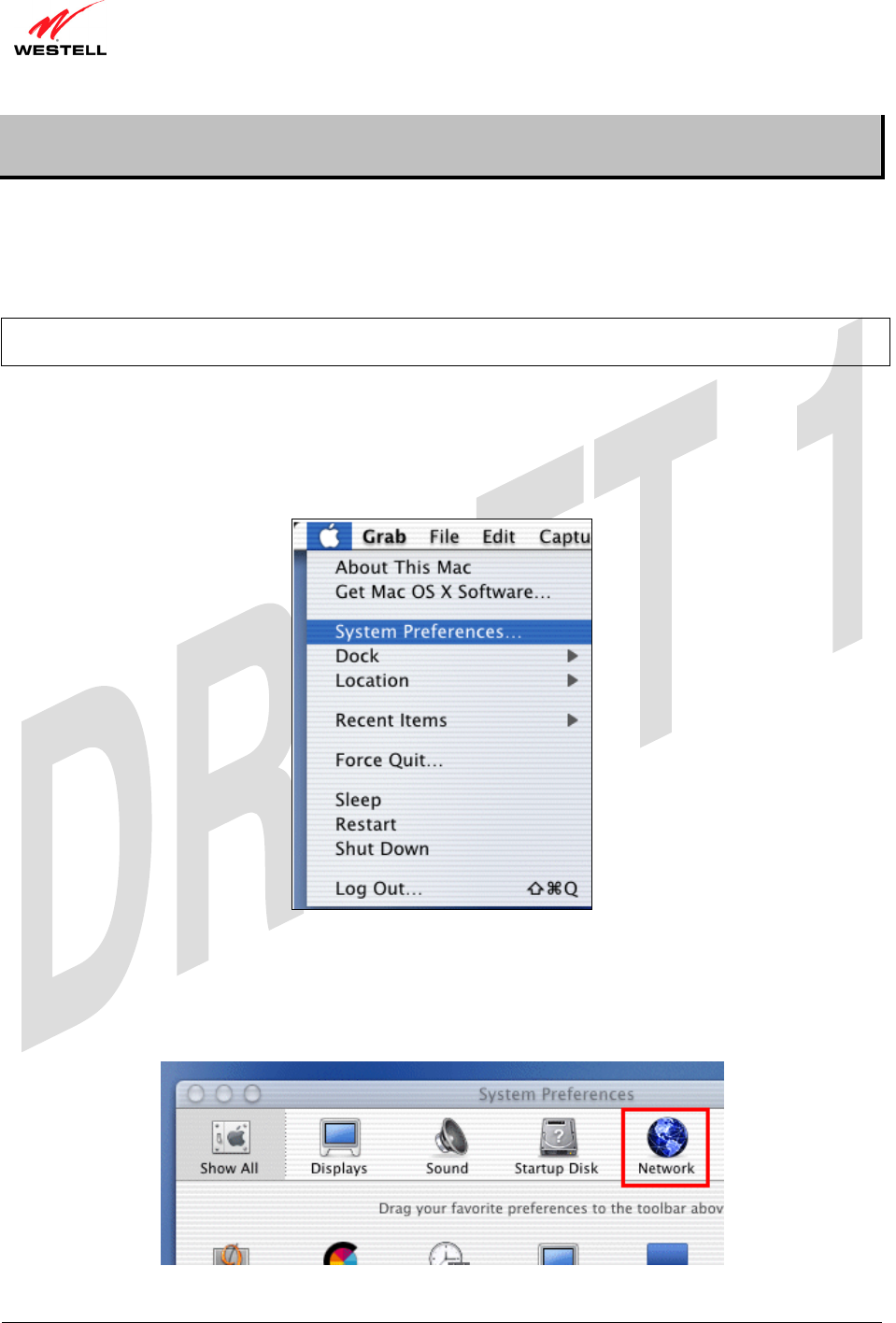
UltraLine II VDSL– Draft 1
030-300237 Rev. A
8/8/06
030-300237 Rev. A 13 August 2006
User Guide UltraLine II VDSL Gateway (Model 826010)
7. SETTING UP MACINTOSH OS X
As of 8/3, this section is TBD. Delfino will review this section and provide feedback in a
couple of weeks.
This section provides instructions on how to use Macintosh Operating System 10 with the Modem. Follow the
instructions in this section to create a new network configuration for Macintosh OS X.
IMPORTANT: Macintosh computers must use the Gateway’s Ethernet installation. Refer to section 6, “Installing
the Hardware.”
7.1 Opening the System Preference Screen
After you have connected the Westell Gateway to the Ethernet port of your Macintosh, click the “Apple” icon in the
upper-right corner of the screen and select System Preferences.
7.2 Choosing the Network Preferences
After selecting System Preferences…, from the previous screen, the System Preferences screen will be displayed.
From the System Preferences screen, click the Network icon.

UltraLine II VDSL– Draft 1
030-300237 Rev. A
8/8/06
030-300237 Rev. A 14 August 2006
User Guide UltraLine II VDSL Gateway (Model 826010)
7.3 Creating a New Location
After selecting the Network icon at the System Preferences screen, the Network screen will be displayed. Select
New Location from the Location field.
7.4 Naming the New Location
After selecting New Location from the Network screen, the following screen will be displayed. In the field labeled
Name your new location:, change the text from “Untitled” to “Westell.” Click OK.
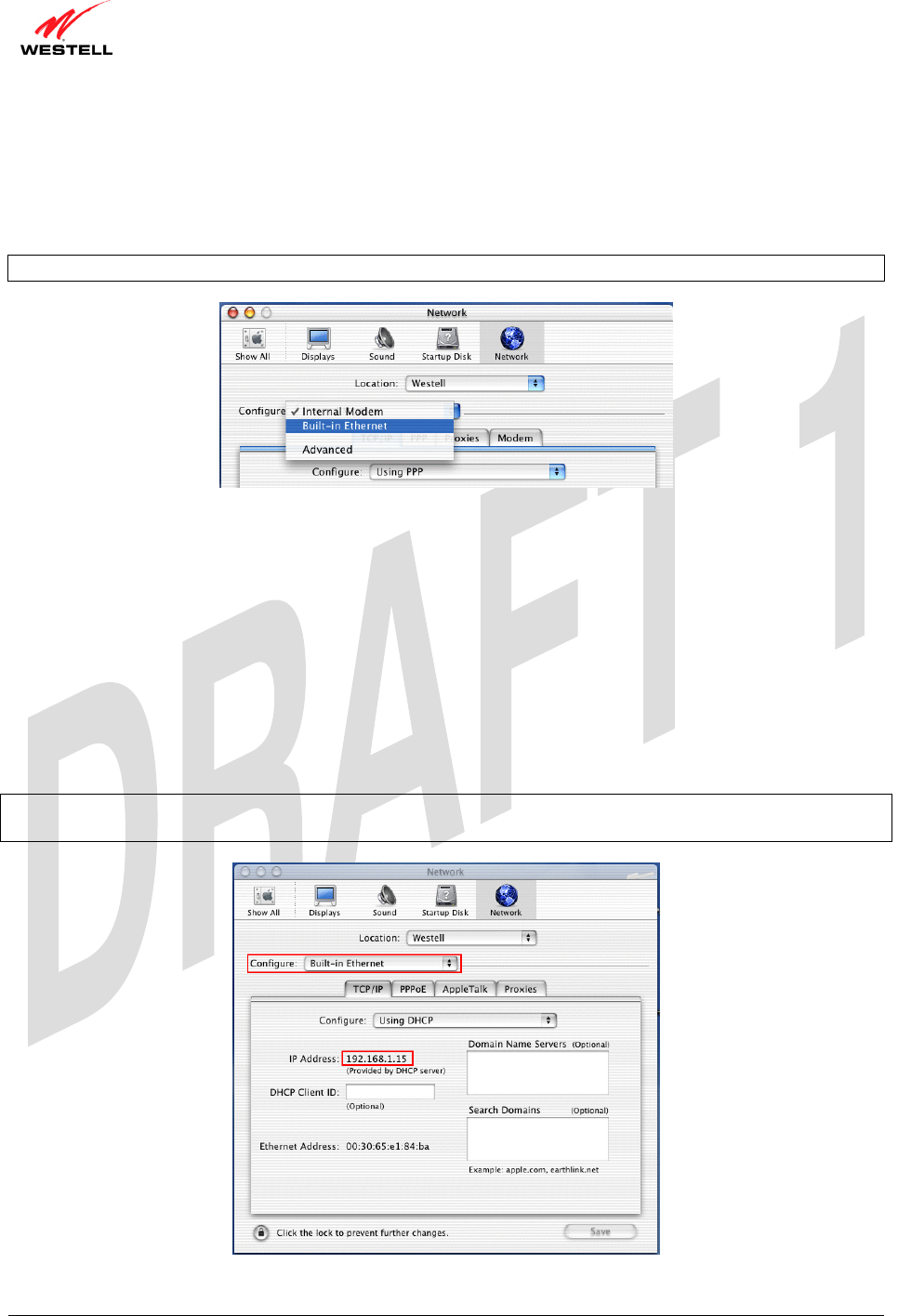
UltraLine II VDSL– Draft 1
030-300237 Rev. A
8/8/06
030-300237 Rev. A 15 August 2006
User Guide UltraLine II VDSL Gateway (Model 826010)
7.5 Selecting the Ethernet Configuration
If you clicked OK in the preceding screen, the Network screen will be displayed. The Network screen shows the
settings for the newly created location. From the Configure field in the Network screen, select Built-in Ethernet.
Click Save.
NOTE: Default settings for the Built-in Ethernet configuration are sufficient to operate the Modem.
7.6 Checking the IP Connection
To verify that the computer is communicating with the Gateway, follow the instructions below.
1. Go to the “Apple” icon in the upper-right corner of the screen and select System Preferences.
2. From the System Preferences screen, click the Network icon. The Network screen will be displayed.
3. From the Configure field in the Network screen, select Built-in Ethernet.
4. View the IP address field. An IP address that begins with 192.168.1 should be displayed.
NOTE: The DHCP server provides this IP address. If this IP address is not displayed, check the Gateway’s wiring
connection to the PC. If necessary, refer to section 5 for hardware installation instructions.
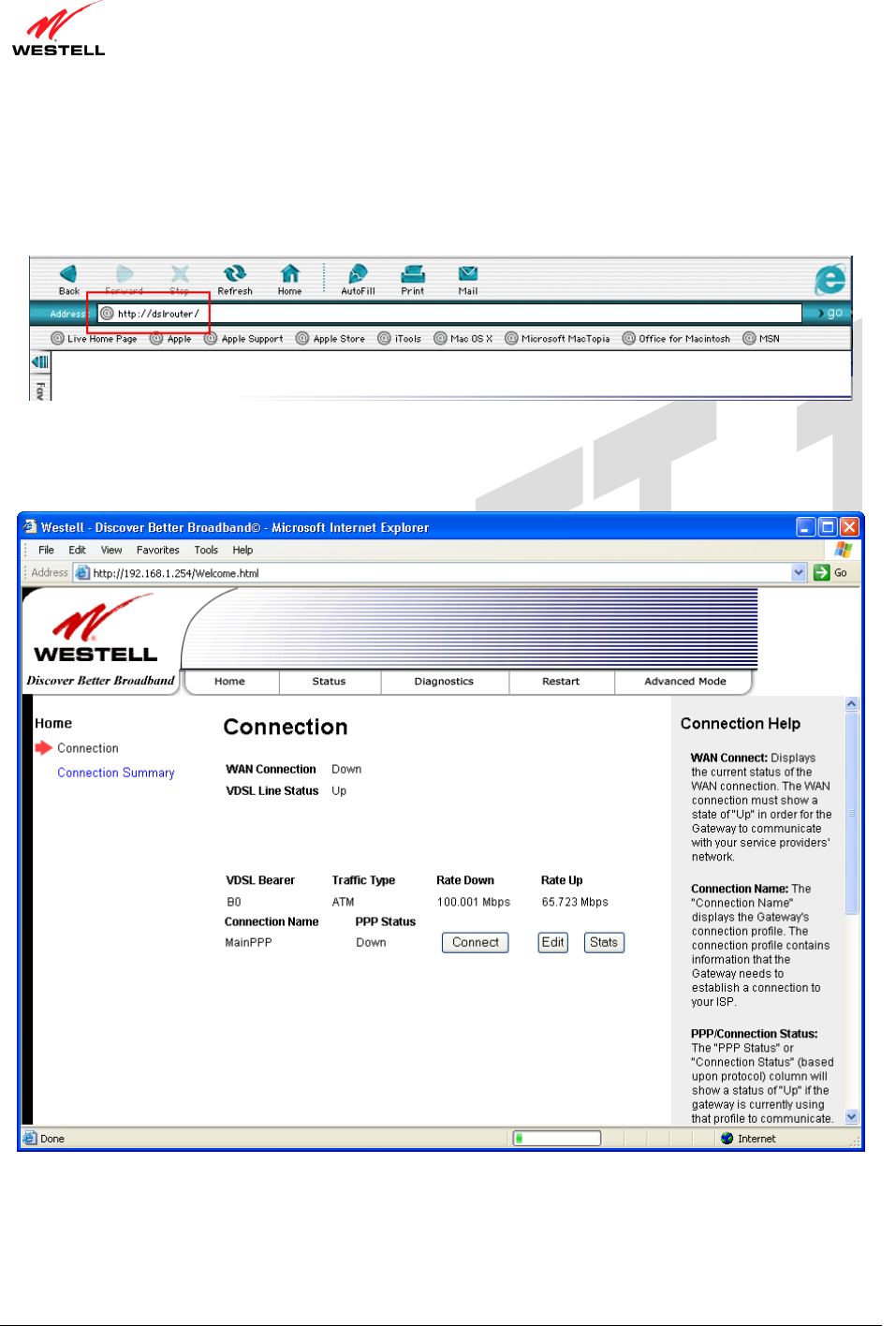
UltraLine II VDSL– Draft 1
030-300237 Rev. A
8/8/06
030-300237 Rev. A 16 August 2006
User Guide UltraLine II VDSL Gateway (Model 826010)
7.7 Accessing the Gateway’s User Interface
To access your Gateway’s user interface from your Macintosh, first start your web browser. Next, type
http://dslrouter/ in the browser’s address bar and press Enter on your keyboard.
After you have accessed the Gateway’s user interface, the following screen will be displayed. Proceed to section 8 to
confirm you VDSL sync, set up your connection profile, and connect to the Internet.

UltraLine II VDSL– Draft 1
030-300237 Rev. A
8/8/06
030-300237 Rev. A 17 August 2006
User Guide UltraLine II VDSL Gateway (Model 826010)
8. CONFIGURING YOUR GATEWAY FOR INTERNET CONNECTION
This section explains the procedures for accessing your VDSL Gateway, setting up you connection profile, and
establishing a WAN connection with you Internet service provider (ISP). Refer to this section whenever you need to
access or make changes to your Gateway or Firewall settings.
8.1 Accessing your VDSL Gateway
IMPORTANT: Your Gateway has the capability of automatically sensing protocol type (DHCP or PPPoE). This
process is designed to start after you have connected your Gateway. To access the Gateway, your PC must be
configured for DHCP. Refer to your Microsoft Windows help screen for information on configuring your computer
for DHCP. Click Start, then click Help to access the Microsoft Windows help screen.
To access your VDSL Gateway, start your web browser and then type the following IP address in the browser’s
address bar:
http://192.168.1.254
After you type the IP address, press Enter on your keyboard. The following screen will appear. Next, proceed to
section 8.2 to confirm your VDSL sync.

UltraLine II VDSL– Draft 1
030-300237 Rev. A
8/8/06
030-300237 Rev. A 18 August 2006
User Guide UltraLine II VDSL Gateway (Model 826010)
8.2 Confirming Your VDSL Sync
Your Gateway must first establish a VDSL sync with your service provider’s equipment in order to have Internet
access. To determine if your Gateway has established a VDSL sync, check the following:
• At the front of the Gateway, check to see if the Gateway’s VDSL LED is solid green. Solid green indicates
that a VDSL sync has been established. (The VDSL LED may flash while the connection is being
established.)
• At the Connection screen, check the VDSL Line Status. If the status displays Down, you do not have a
VDSL connection. If the Rate Down/Rate Up fields display numeric values, a VDSL sync has been
established, and the VDSL Line Status should display Up.
IMPORTANT: Confirm that the VDSL Line Status displays Up before proceeding with the Gateway’s
configuration. If you do not have a VDSL sync, first check your physical connections (refer to section 6, “Installing
the Hardware,” if needed). Then, if the problem persists, contact your ISP for further instructions.
After you have confirmed that your VDSL Line Status is UP, proceed to section 8.3, “Setting Up Your Connection
Profile.”
NOTE: If your Gateway has established a VDSL sync and if you are connecting via DHCP, follow the instructions
provided by your Internet service provider to connect to the Internet. However, if you are connecting to the Internet
via PPP, proceed to section 8.3 to set up your connection profile.

UltraLine II VDSL– Draft 1
030-300237 Rev. A
8/8/06
030-300237 Rev. A 19 August 2006
User Guide UltraLine II VDSL Gateway (Model 826010)
8.3 Setting Up Your Connection Profile
After you have confirmed your VDSL sync, you are ready to set up your connection profile. When connecting to the
Internet via PPP, you will use your connection profile to identify yourself to your ISP. Connection profiles can be
associated with specific service settings such as connection settings or NAT services, enabling you to customize
your Gateway for specific users.
IMPORTANT: Before you set up a connection profile, obtain your Account ID and Account Password from your
Internet service provider. You will use this information when you set up your account parameters. If you are at a
screen and need help, refer to the Help section located at the right of the screen.
Click Edit to begin your profile set up.
If you clicked Edit, the following screen will be displayed. This screen enables you to add new connection profiles
or to edit existing connection profiles in your account. The Connection Name field enables you to enter the desired
name that you wish to use for each profile that you set up. You may create and store up to eight unique connection
profiles in your Gateway, which you can use once you establish a PPP session with your ISP.
Profile Parameters include:
● Connection Name-the Connection Name is a word or phrase that you use to identify your account.
(You may enter up 64 characters in this field.)
● Account ID-the Account ID is provided by your Internet Service Provider.
(You may enter up 255 characters in this field.)
● Account Password-the Account Password is provided by your Internet Service Provider.
(You may enter up 255 characters in this field.)
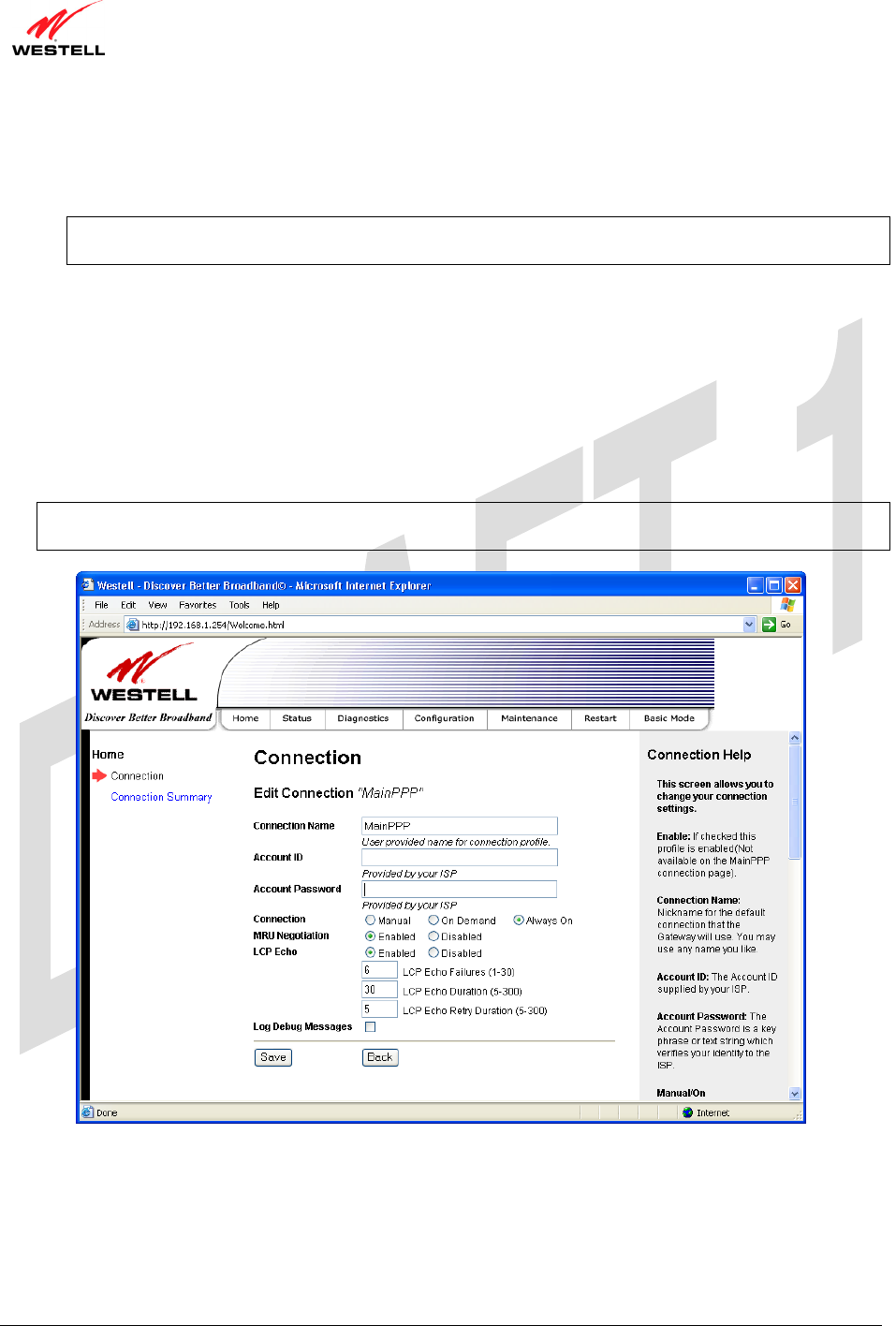
UltraLine II VDSL– Draft 1
030-300237 Rev. A
8/8/06
030-300237 Rev. A 20 August 2006
User Guide UltraLine II VDSL Gateway (Model 826010)
At the Edit Connection screen, complete the following steps to set up your connection profile:
1. Type your Connection Name, Account ID and Account Password in the fields provided. The Account
Password field will be masked with asterisks for security.
NOTE: The Connection Name is the name that you will use for this connection profile. The Account ID
and Account Password are provided by your Internet service provider.
2. At the field labeled Connection, select the connection type (Manual, On Demand, Always On) that you
want to associate this Connection Name. The factory default Connection Name is “MainPPP. The factory
default connection setting is “Always On.” You can change the default connection setting, if desired.
(Connection settings are explained in the following table.)
3. Select the MRU Negotiation and LCP settings that you want to use for this connection. For details on these
settings, refer to the following table.
4. Click Save to save any changes that you have made to this screen.
5. Click Back to return to the main Connection screen.
NOTE: If you click Back before you click Save, the previously saved settings will remain active, and any
recent changes that you have made to this screen will not take effect. You must click Save to save the settings.

UltraLine II VDSL– Draft 1
030-300237 Rev. A
8/8/06
030-300237 Rev. A 21 August 2006
User Guide UltraLine II VDSL Gateway (Model 826010)
Connection
Edit Connection Factory Default = MainPPP
The name of the default connection profile. Westell recommends that you use the
Default parameter.
Connection Name This field allows you to enter a new connection name of your choice (up to 64
characters).
Account ID The account ID (provided by your Internet service provider).
Account Password The account password that you are using to connect to your Internet service
provider (provided by your Internet service provider).
Connection Factory default = Always On
Manual: Selecting this feature allows you to manually establish your PPP
session.
On Demand: Selecting this feature allows the Modem to automatically re-
establish your PPP session on demand anytime your PC requests Internet activity
(for example, browsing the Internet, email, etc.). When you have traffic, it may
cause a delay.
Always On: Selecting this feature allows the Modem to automatically establish a
PPP session when you log on or if the PPP session goes down.
MRU Negotiation Factory Default = Enabled
When Enabled, the Maximum Received Unit (MRU) will enforce MRU
negotiations.
If Disabled, this function will not be activated.
LCP Echo Factory Default = Enable
If ‘Disabled’ is selected, this option will disable the Modem LCP Echo
transmissions.
LCP Echo Failures Factory Default = 6
Indicates number of continuous LCP echo non-responses received before the PPP
session is terminated. This value must be between 1 and 30 inclusive.
LCP Echo Duration Factory Default = 30
The interval between LCP Echo transmissions with responses. This value must
be between 5 and 300 seconds inclusive and greater than or equal to the Retry
Duration.
LCP Echo Retry Duration Factory Default = 5
The interval between LCP. Echo after no response.
This value must be between 5 and 300 seconds inclusive.
Log Debug Messages Factory Default = Disabled
When Enabled (box is checked), the Modem will send log debug messages to the
syslog server.

UltraLine II VDSL– Draft 1
030-300237 Rev. A
8/8/06
030-300237 Rev. A 22 August 2006
User Guide UltraLine II VDSL Gateway (Model 826010)
8.4 Establishing a WAN Connection
If you clicked Save (to save your connection profile) and then clicked Back in the preceding Connection screen, the
following Enter Network Password screen will be displayed. Type the default User Name (which is bellsouthtech)
and default Password (which is be11s0uth) into the fields provided. Click OK to continue.
IMPORTANT: Notice the 1’s and the 0 used the network password. You must enter this network password before
you can establish a WAN Connection. Your Internet service provider will provide you with these values.
After you have entered your network name and password and clicked OK in the preceding screen, the following
Connection screen will appear. At the Connection screen, confirm that the WAN Connection field displays Up.
When WAN Connection displays Up, this means that you have established a PPP session with your Internet service
provider (ISP). If WAN Connection displays Down, ensure that the VDSL Line Status field displays Up, and then
click Connect to establish a PPP session with your ISP. After a PPP session has been established, the WAN
Connection field should display UP. (Note: The VDSL Line Status must be Up in order to establish WAN
connectivity.)
IMPORTANT: Whenever the WAN Connection field displays Down, you do not have a PPP session established.
If your Gateway’s connection profile is set to “Always On” or “On Demand,” after a brief delay, the PPP session
will be established automatically and the WAN Connection field will display Up. If the connection setting is set to
“Manual,” you must click the Connect button to establish a PPP session. Once the PPP session has been established
(WAN Connection displays UP), you can proceed with your Gateway’s configuration. (Refer to the preceding Edit
Connection screen if you desire to change your connection settings.) The factory default connection setting is
“Always On.”
bellsouthtech
be11s0uth
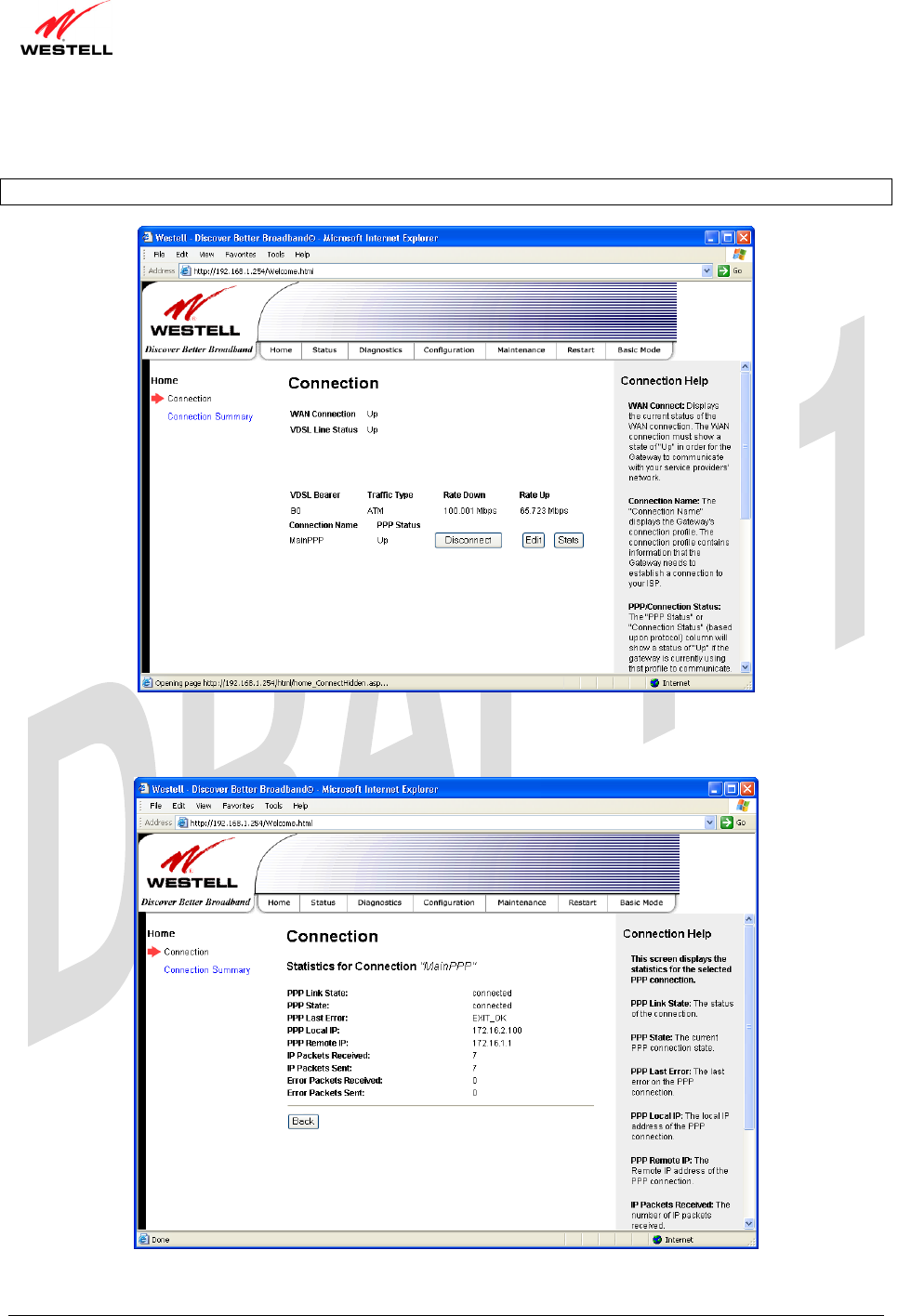
UltraLine II VDSL– Draft 1
030-300237 Rev. A
8/8/06
030-300237 Rev. A 23 August 2006
User Guide UltraLine II VDSL Gateway (Model 826010)
The following screen displays Up in the PPP Status field. This indicates that MainPPP is the active connection
profile and that you have established a PPP session with your ISP.
NOTE: If you experience problems establishing a WAN Connection, contact your ISP for further instructions.
If you click the Stats button, the following screen will be displayed. This screen displays the statistics for the
selected PPP connection. When you have finished viewing this screen, click Back.

UltraLine II VDSL– Draft 1
030-300237 Rev. A
8/8/06
030-300237 Rev. A 24 August 2006
User Guide UltraLine II VDSL Gateway (Model 826010)
After a PPP session has been established, you can browse the Internet. For example, to visit BellSouth’s home page,
type http://bellsouth.com in your browser’s address bar, and then press Enter on your keyboard.
When you are ready to return to the Gateway’s interface, type http://192.168.1.1 in your browser’s address bar, and
then press Enter on your keyboard. Next, proceed to section 9, “Basic Mode,” to begin the basic configurations of
your Gateway.
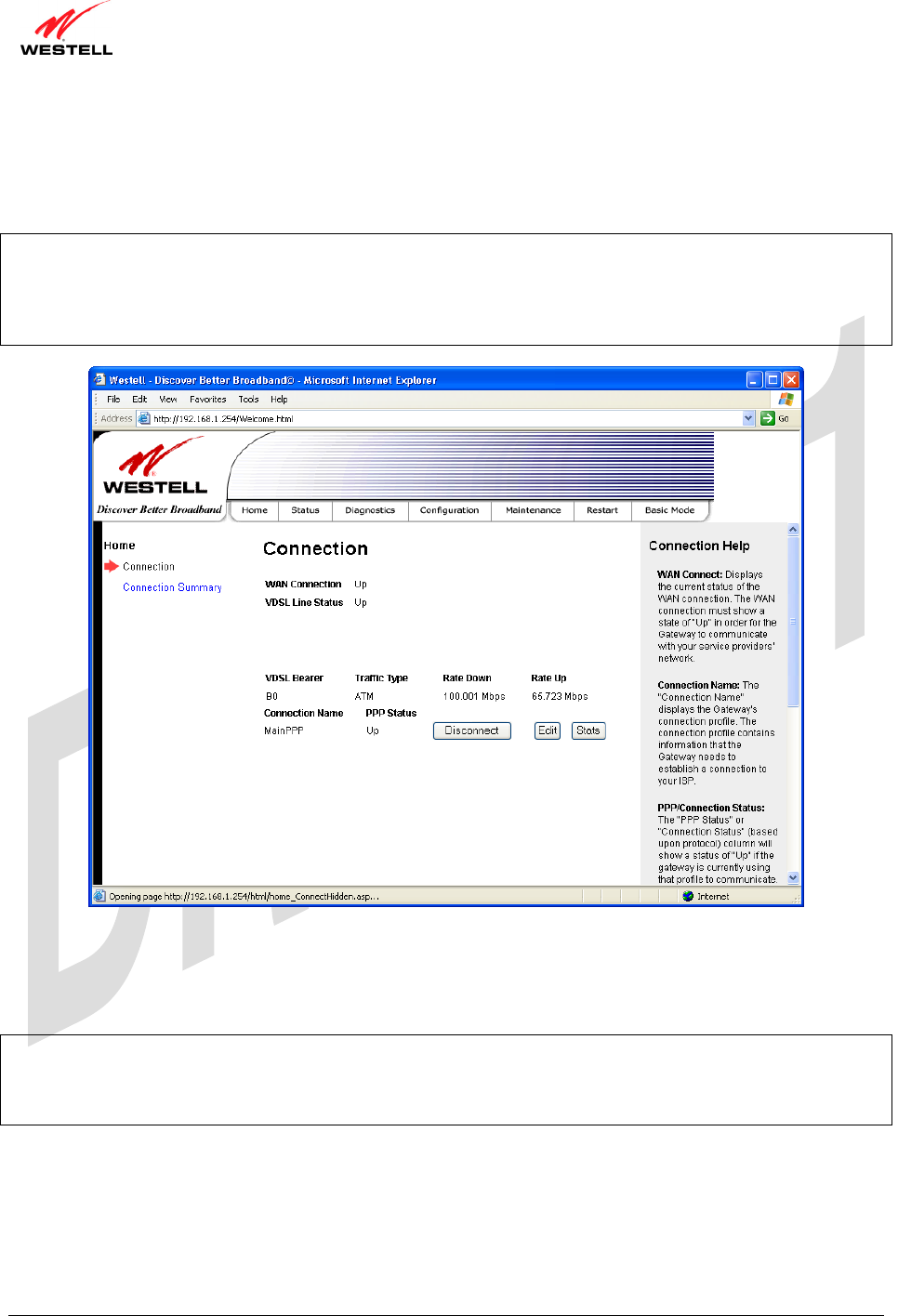
UltraLine II VDSL– Draft 1
030-300237 Rev. A
8/8/06
030-300237 Rev. A 25 August 2006
User Guide UltraLine II VDSL Gateway (Model 826010)
8.5 Disconnecting Your WAN Connection
If you have finished browsing the Internet and want to disconnect from your Internet service provider, click
Disconnect in the Connection screen.
CAUTION: If you click Disconnect, this will disconnect the Gateway from the Internet, and Internet access for all
users connected to the Gateway will be down until the WAN connection (PPP session) is re-established. The WAN
Connection field will display Down; however, your VDSL sync will not be affected, VDSL Line Status will remain
Up. If you want to end your VDSL session, simply power down the Gateway via the power switch on the Gateway’s
rear panel.
When you are ready to re-establish a WAN connection, click Connect and wait a brief moment for the WAN
Connection to display UP. If you powered down your Gateway, you must first power up the Gateway, and then log
in to your connection profile to establish a WAN connection, as explained in section 8.4, “Establishing a WAN
Connection.”
NOTE: When you are ready to exit the Gateway’s interface, click the X (close) in the upper-right corner of the
screen. Closing the screen will not affect your PPP Status or your WAN connection. When you are ready to restore
the Gateway’s screen, you must launch your Internet browser and type http://192.168.1.1/ in the browser’s address
bar, and then press Enter on your keyboard.
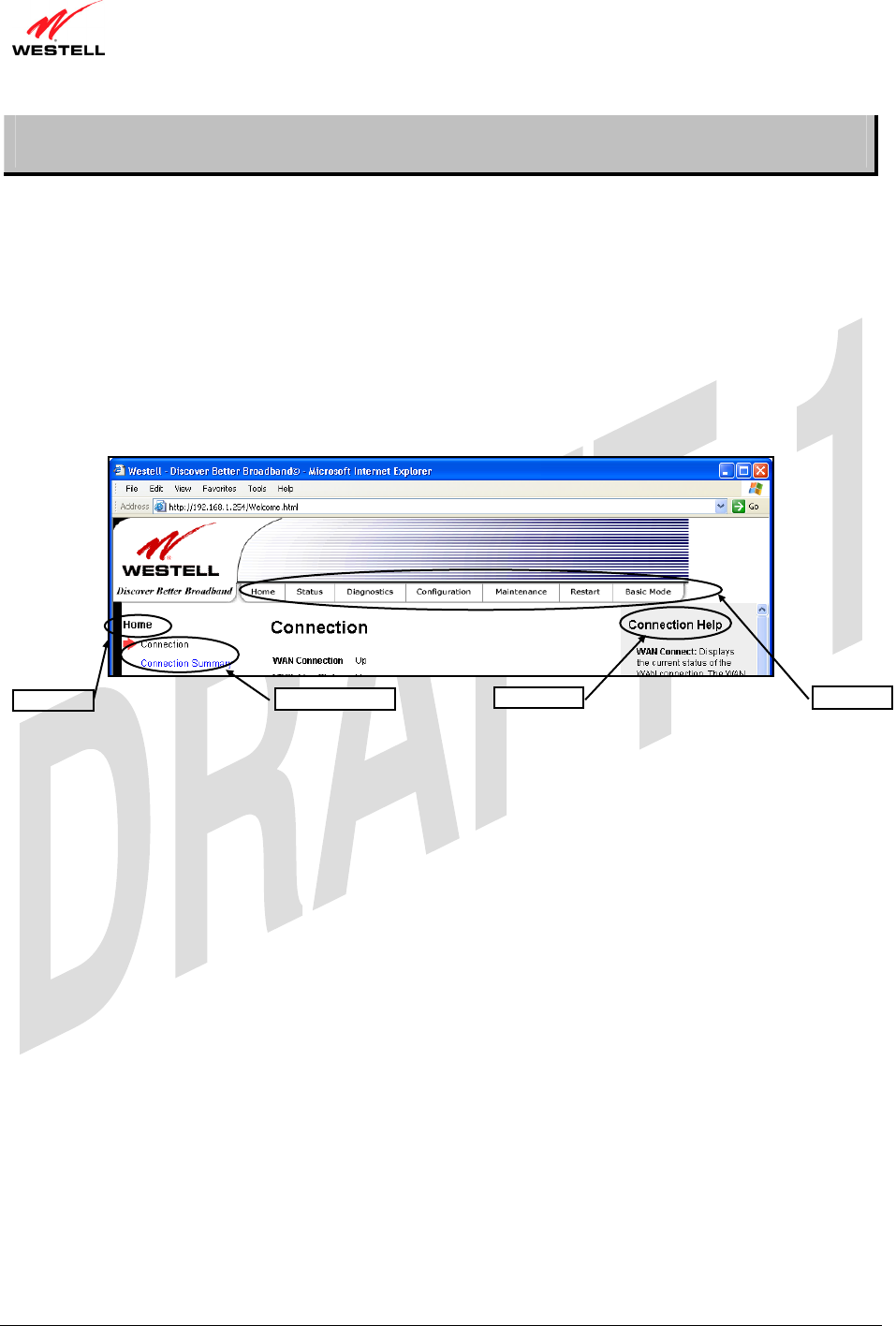
UltraLine II VDSL– Draft 1
030-300237 Rev. A
8/8/06
030-300237 Rev. A 26 August 2006
User Guide UltraLine II VDSL Gateway (Model 826010)
9. BASIC MODE
The following sections explain the basic configurations of your Gateway. The Gateway’s web pages contain a main
navigation menu, displayed at the top of the screens. As you navigate through the various pages of the Gateway, the
active page that you have selected from the menu options will appear in the left corner of the screen. The submenu
options for that page will appear in the left-side navigation menu, as shown below. A red arrow will be displayed
adjacent to the active submenu option. Please note that the values displayed in this User Guide might differ from the
actual values reported by your Gateway. If you are at a screen and need help, refer to the Help section displayed on
the right side of the screen. Additional details are displayed in the tables below the screens.
Some screens require that you save your settings. To save your settings, click the Save button. To discard changes
that you have made to the screen, click the Discard button. If you click the Discard button, the previously saved
settings will be displayed in the screen.
Main Menu
Help Section
Active Page Submenu Options

UltraLine II VDSL– Draft 1
030-300237 Rev. A
8/8/06
030-300237 Rev. A 27 August 2006
User Guide UltraLine II VDSL Gateway (Model 826010)
10. HOME
10.1 Connection
The following screen will be displayed if you select Home > Connection from main menu. The Connection screen
provides information about your Gateway’s connections. As explained in section 8, when the VDSL and WAN
connection fields display UP, you have established a connection with your ISP and can browse the Internet,
NOTE: The values displayed in this User Guide might differ from the actual values reported by your Gateway.
Connection
WAN Connection Displays status of your WAN connection.
VDSL Line Status Displays the status of your VDSL connection.
VDSL Bearer The VDSL bearer that carries the data transmission.
Traffic Type The medium over which data is transmitted.
Rate Down/Rate Up The downstream/upstream rate of the data transmission.
Connection Name The Connection Name is from the connection profile that you set up in section 8.3.
PPP Status Up = WAN connection (PPP session) is established.
Down = WAN connection is not established.
Connect/Disconnect Click Connect to establish a WAN connection.
Click Disconnect to disconnect a WAN connection.
Edit Click Edit to edit or add a connection profile. Refer to section 8.3. for details on
connection profiles.
Stats Click Stats to view statistical information about your WAN connection.
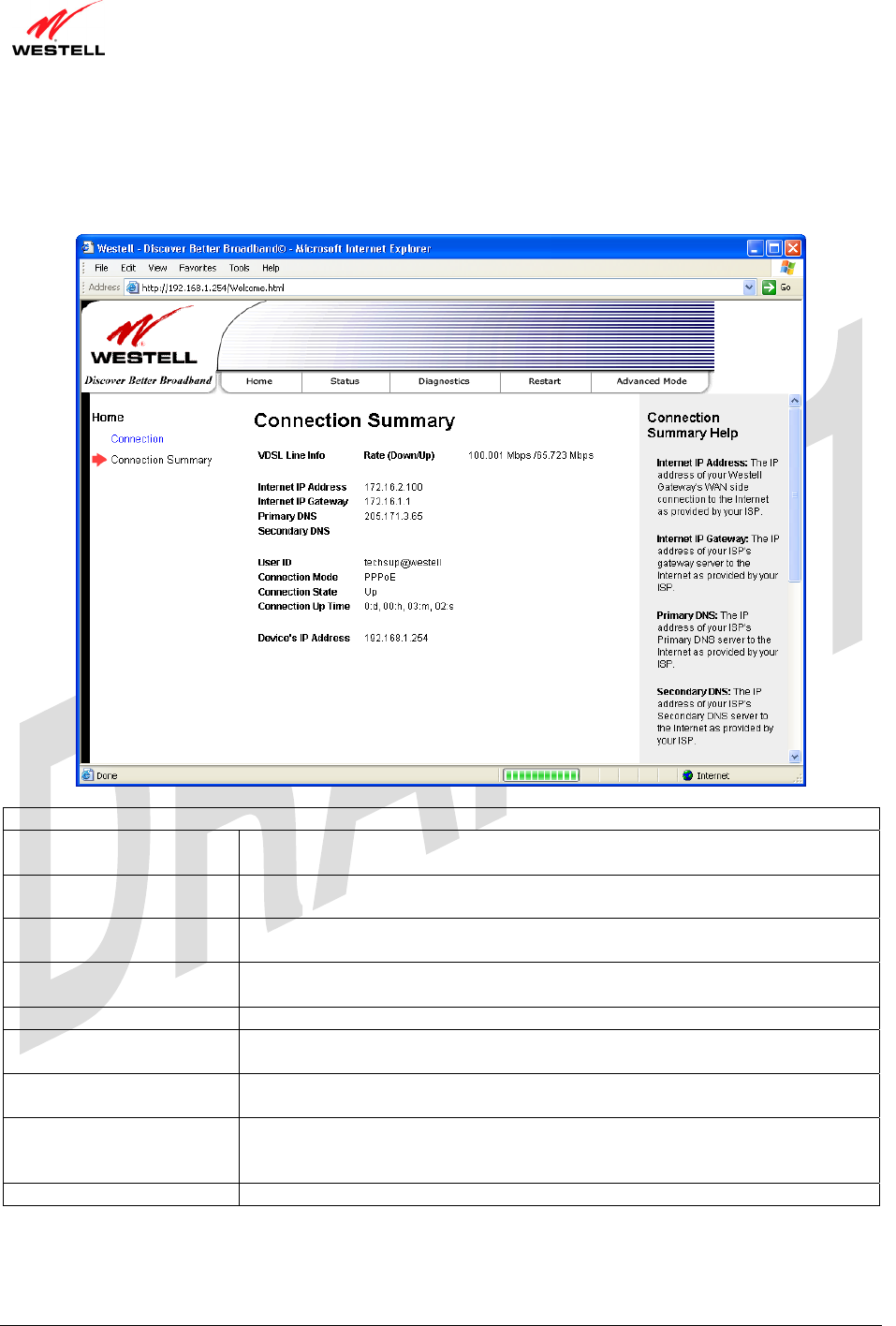
UltraLine II VDSL– Draft 1
030-300237 Rev. A
8/8/06
030-300237 Rev. A 28 August 2006
User Guide UltraLine II VDSL Gateway (Model 826010)
10.2 Connection Summary
The following screen will be displayed if you select Home > Connection Summary from the menu options. Refer
to this screen for information about your Gateway’s connections.
Connection Summary
Internet IP Address The WAN side or Gateway’s IP address to the Internet. Provided by your Internet
service provider.
Internet IP Gateway The IP address of your ISP’s server to the Internet. Provided by your Internet
service provider.
Primary DNS The IP address of your ISP’s primary DNS server. Provided by your Internet
service provider.
Secondary DNS The IP address of your ISP’s secondary DNS server. Provided by your Internet
service provider.
User ID The same as your Account ID. Provided by your Internet service provider.
Connection Mode The Gateway’s mode of connection to your ISP. The protocol can either be PPPoE
or Routed IP.
Connection State The Gateway’s PPP connectivity status to the Internet. The VDSL state and WAN
connection must be Up in order for connection state to be Up.
Connection Up Time The duration of your PPP time status. This time field tells how long the Gateway
has had a PPP connection established, displayed in the format of
(days:hours:minutes:seconds).
Device’s IP Address The IP address on the LAN side of your Gateway.

UltraLine II VDSL– Draft 1
030-300237 Rev. A
8/8/06
030-300237 Rev. A 29 August 2006
User Guide UltraLine II VDSL Gateway (Model 826010)
11. STATUS
11.1 About
The following screen will be displayed if you select Status > About from the menu options. This screen displays the
manufacturer’s information about your Gateway.
About
Gateway Type The manufacturer’s description for this device.
Model Number The manufacturer’s model number.
Serial Number The manufacturer’s serial number.
Software Version The version of the application software and the build date.
Boot Loader The manufacturer’s boot loader software version number.
INI File The manufacturer’s INI information for the device.
MAC Address Media Access Controller (MAC) i.e., hardware address.
Warranty Date The warranty start date for this device.

UltraLine II VDSL– Draft 1
030-300237 Rev. A
8/8/06
030-300237 Rev. A 30 August 2006
User Guide UltraLine II VDSL Gateway (Model 826010)
11.2 LAN Devices
The following screen will be displayed if you select Status > LAN Devices from the menu options. This screen
displays all the devices connected to your LAN.
LAN Devices
IP Address The assigned IP address of the networking devices on your LAN.
MAC Address The assigned Ethernet MAC (i.e., hardware) address of the networking devices on
your LAN.
Name The computer’s assigned name provided to the Gateway through DNS lookup. (The
computer name or the IP address may be displayed in this field.)
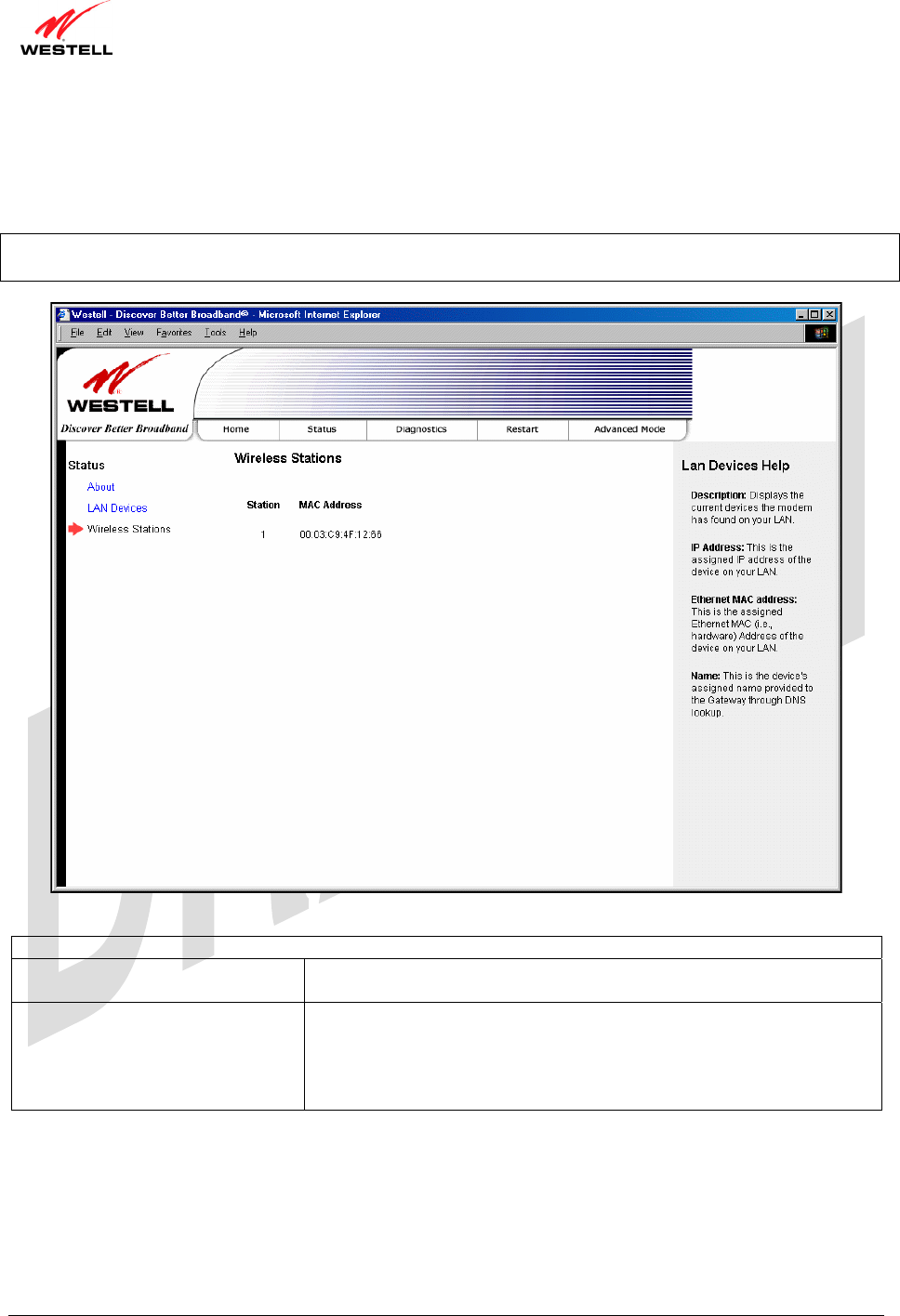
UltraLine II VDSL– Draft 1
030-300237 Rev. A
8/8/06
030-300237 Rev. A 31 August 2006
User Guide UltraLine II VDSL Gateway (Model 826010)
11.3 Wireless Stations
The following screen will be displayed if you select Status > Wireless Stations from the menu options. This screen
displays the information about the wireless stations that are associated with your Gateway.
NOTE: The Station and MAC Address fields in this screen will be blank if no wireless stations are associated with
your Gateway.
Wireless Stations
Station A number indicating the order in which stations have accessed the
Gateway. This list can contain a maximum of 10 stations.
MAC Address The Media Access Controller (MAC) address (i.e., the hardware address
of the associated station). This is a unique number entered into the WLAN
device’s permanent memory during production. A station’s MAC address
is typically printed on the card or can be viewed using the card’s
configuration utility.

UltraLine II VDSL– Draft 1
030-300237 Rev. A
8/8/06
030-300237 Rev. A 32 August 2006
User Guide UltraLine II VDSL Gateway (Model 826010)
12. DIAGNOSTICS
The following screen will be displayed if you select Diagnostics from the menu options. This screen allows you to
run diagnostic tests on your Gateway.
• To run a DNS test, type the appropriate host name in the field provided, and then click Test.
• To run a PING test, type the appropriate IP address or host name in the field provided, and then click Test.
• To run a Trace Route, type the appropriate IP address or host name in the field provided, and then click Trace.
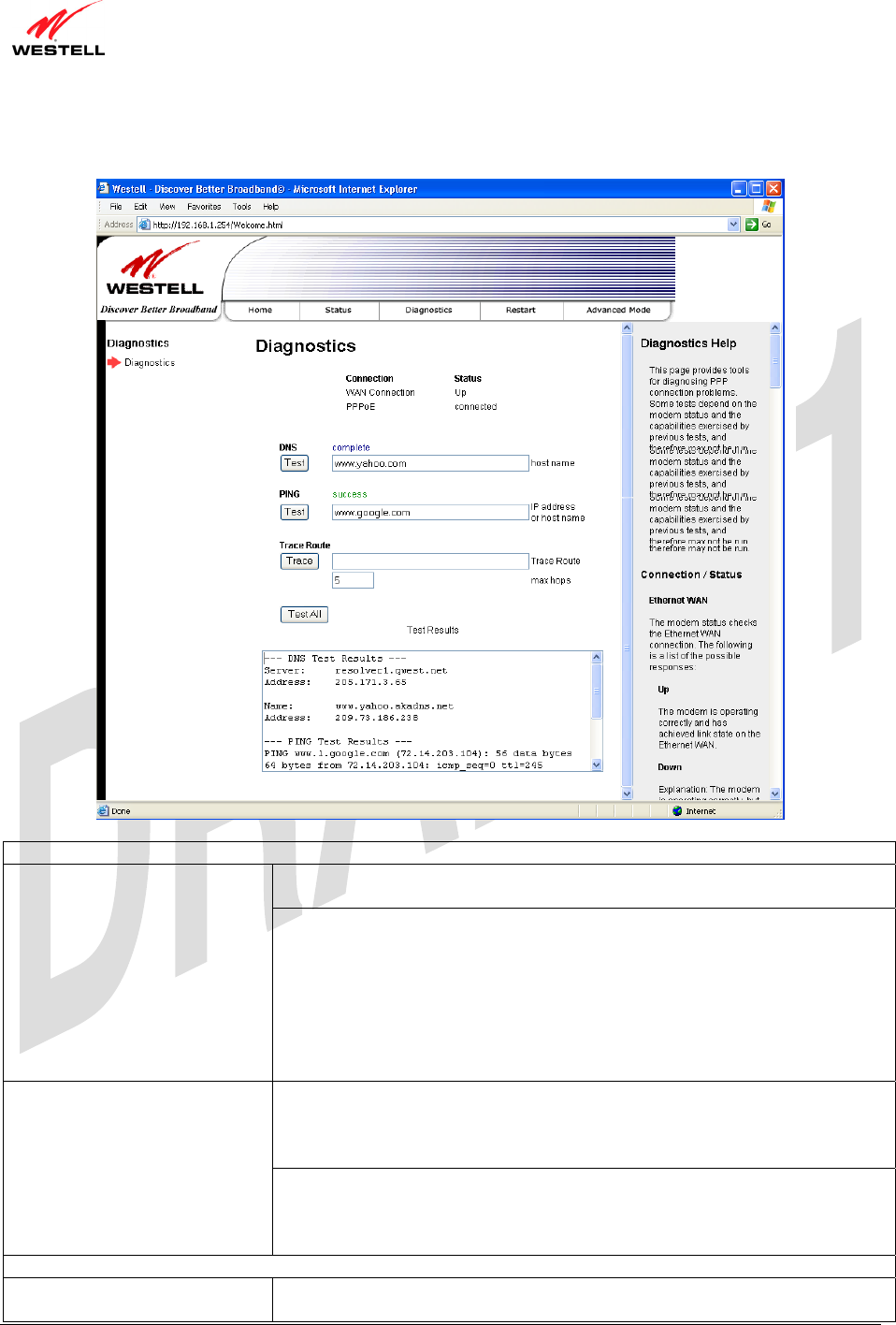
UltraLine II VDSL– Draft 1
030-300237 Rev. A
8/8/06
030-300237 Rev. A 33 August 2006
User Guide UltraLine II VDSL Gateway (Model 826010)
If you click Test All, the following screen will be displayed, and the results will be displayed in the window labeled
Test Results.
Diagnostics
The first line displays WAN Connection. This the type of connection used to
establish your Internet connection.
Connection
The second line displays the protocol used to establish the session and the status
of the session. This is a specific format used for transmitting data on your ISP’s
network to access the Internet. You ISP will inform you of the protocol to use
for your Internet connection.
Possible Responses:
PPPoE – Point-to-Point protocol over Ethernet
Bridge – Bridging protocol
Routed IP – Routed IP protocol
The first line displays the status of the physical interface connection.
Possible Responses:
Up – The interface connection is Up.
Down – The interface connection is Down.
Status The second line indicates the status of the protocol.
Possible Responses:
Connected – The protocol is connected.
Disconnected – The protocol is disconnected.
Test Description / Test Results
DNS Performs a test to try to resolve the name of a particular host. The host name is
entered in the input box.

UltraLine II VDSL– Draft 1
030-300237 Rev. A
8/8/06
030-300237 Rev. A 34 August 2006
User Guide UltraLine II VDSL Gateway (Model 826010)
Possible responses are:
Success: The Router has successfully obtained the resolved address. The IP
address is shown below the host name input box.
No Response: The Router has failed to obtain the resolved address.
Host not found: The DNS Server was unable to find an address for the given
host name.
No data, enter host name: No host name is specified.
Could not test: The test could not be executed due to the Router’s settings.
Check your DSL sync or your PPP session. You must have both a DSL sync
and a PPP connection established to execute a PING.
IP Address IP Address of the Host Name.
PING
(via IP Address or Host Name)
Performs an IP connectivity check to a remote computer either within or beyond
the Service Provider’s network. You can PING a remote computer via the IP
address or the DNS address. If your PING fails, try a different IP or DNS
address.
Possible responses are:
Success: The Remote Host computer was detected.
No Response: There was no response to the Ping from the remote computer.
No name or address to PING: No host name or IP address was specified.
Could not test: The test could not be executed due to the Router settings. Check
your DSL sync or your PPP session. You must have both a DSL sync and a PPP
connection established to execute a PING.
Trace Route
Determines the route taken to destination by sending Internet Control Message
Protocol (ICMP) echo packets with varying IP Time-To-Live (TTL) values to
the destination. Trace Route is used to determine where the packet is stopped on
the network.
Max hops The number of hops from the Router to the specified destination.
Test All Allows you to run a full diagnostic test.

UltraLine II VDSL– Draft 1
030-300237 Rev. A
8/8/06
030-300237 Rev. A 35 August 2006
User Guide UltraLine II VDSL Gateway (Model 826010)
13. RESTART
The following screen will be displayed if you select Restart from the menu options.
• To erase your stored configuration settings, click the check box labeled Reset device to configuration to
factory defaults (a check mark will appear in the box). Next, click the Restart to restart the Gateway.
• To reset the Gateway without erasing your store configuration settings, leave the box uncheck and click
Restart.
IMPORTANT: If you check mark the box, all of your configuration settings will be lost, and the Gateway will be
reset to factory default settings when you click Restart.
After you click the Restart button, the following pop-up screen will be displayed. Click OK to continue. Click
Cancel if you do not want to restart the Gateway.

UltraLine II VDSL– Draft 1
030-300237 Rev. A
8/8/06
030-300237 Rev. A 36 August 2006
User Guide UltraLine II VDSL Gateway (Model 826010)
If you clicked OK in the preceding pop-up screen, the following screen will be displayed. Please wait a brief
moment for your Gateway to restart. After your Gateway has restarted, the Edit Connection screen will be
displayed.
At the Edit Connection screen, confirm that the PPP Status field displays Up before proceeding with your
Gateway’s configuration.
NOTE: If you have chosen to reset the Gateway to the factory default configuration, you must set up your
connection profile and establish your connection as previously explained in section 8.3 “Setting Up Your
Connection Profile.” Until then, the WAN connection field will display Down.
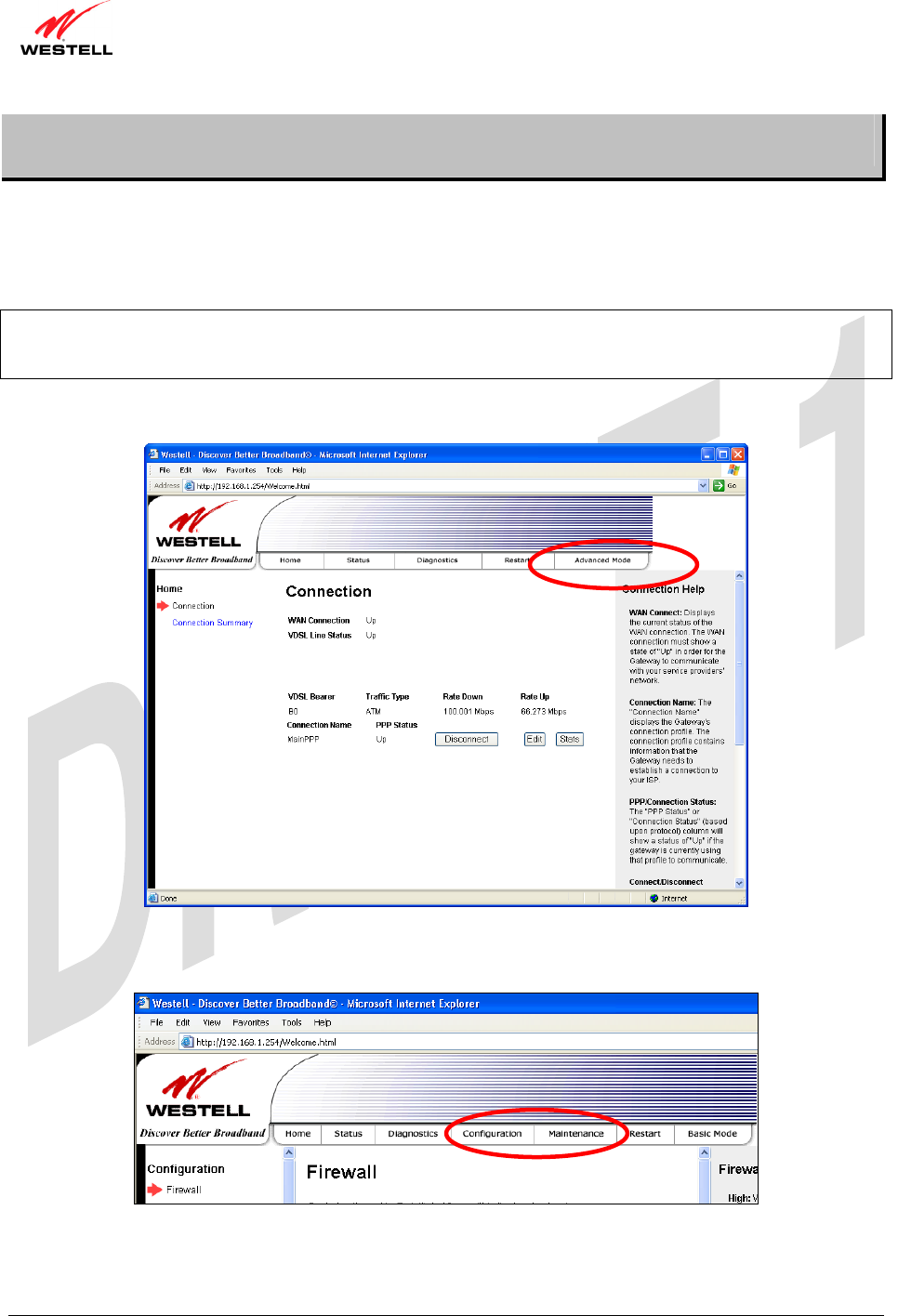
UltraLine II VDSL– Draft 1
030-300237 Rev. A
8/8/06
030-300237 Rev. A 37 August 2006
User Guide UltraLine II VDSL Gateway (Model 826010)
14. ADVANCED MODE
The basic operations of your Gateway were discussed earlier in this User Guide and provided details on the Home,
Status, Diagnostics, and Restart features. For instructions on configuring any of these features, refer to the Basic
Mode sections (beginning with section 9). The remainder of the document will discuss the advanced configurations
of your Gateway.
IMPORTANT: If you change any of the settings in the screens, you must click the Save button to allow the
changes to take effect. If you click Discard, the screen will refresh and the previously saved settings will be
displayed.
To configure the advanced operations of your Gateway, first select Advanced Mode from the menu options.
After you click Advanced Mode, the main menu options for Advanced Mode will be displayed. Select the desired
main menu option, and then select from the submenu options displayed at the left of the screen.
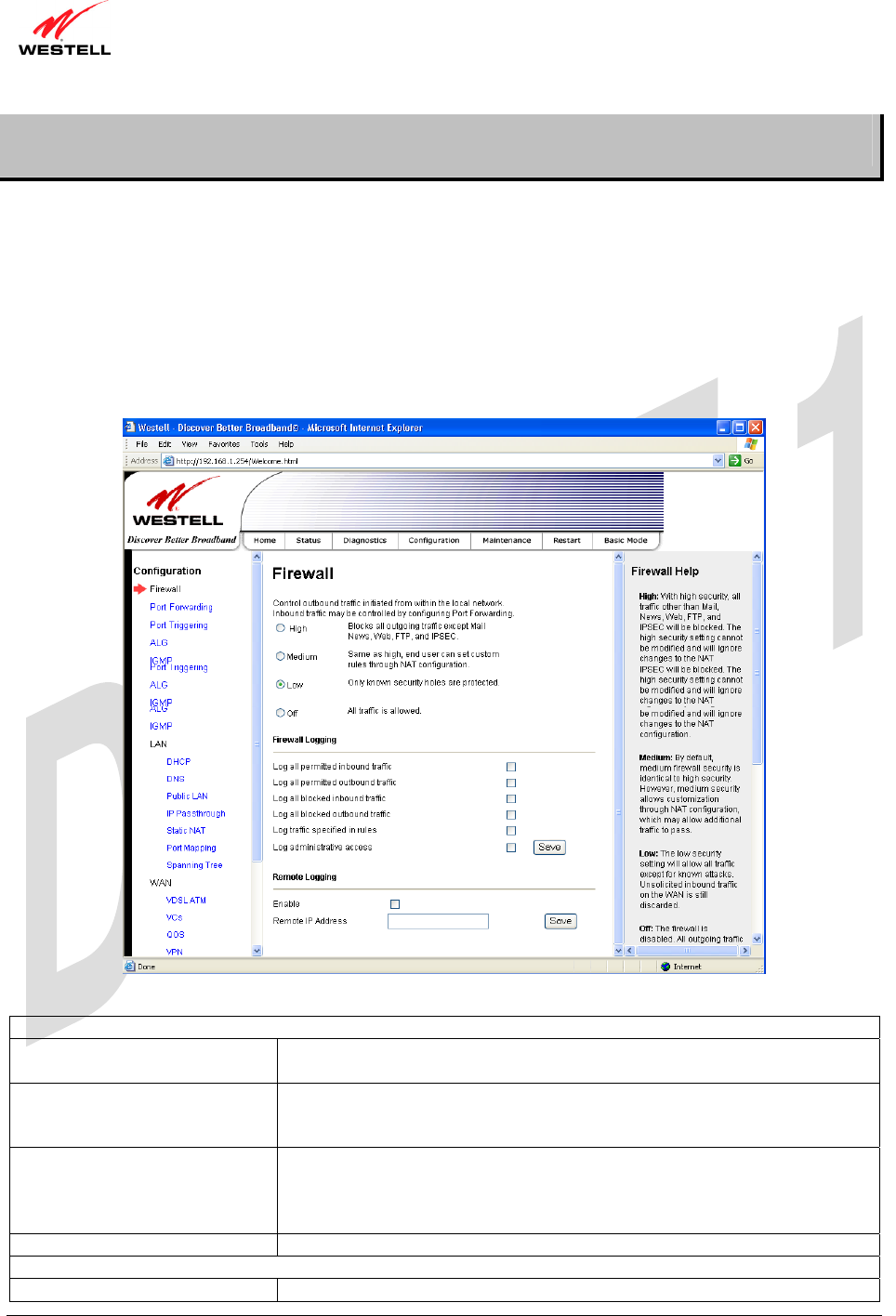
UltraLine II VDSL– Draft 1
030-300237 Rev. A
8/8/06
030-300237 Rev. A 38 August 2006
User Guide UltraLine II VDSL Gateway (Model 826010)
15. CONFIGURATION
15.1 Firewall Configuration
The following screen will be displayed if you select Configuration > Firewall from the menu options. If you
change any settings in this screen, you must click Save to save the settings.
The firewall enforces rules about what network traffic is allowed to enter or leave your computer or network. The
firewall comes with some preconfigured rules and you can add more rules, if desired. After the rules are in place, the
firewall examines all network traffic and drops the traffic if the rules prohibit it.
Security Level
High High security level only allows basic Internet functionality. Only Mail, News,
Web, FTP, and IPSEC are allowed. All other traffic is prohibited.
Medium Like High security, Medium security only allows basic Internet functionality
by default. However, Medium security allows customization through NAT
configuration so that you can enable the traffic that you want to pass.
Low Factory Default = Low
The Low security setting will allow all traffic except for known attacks. If
security is set to Low, the Gateway will be visible to other computers on the
Internet.
Off Firewall is disabled. (All traffic is passed)
Firewall Logging
Log all permitted inbound traffic Factory Default = Disabled

UltraLine II VDSL– Draft 1
030-300237 Rev. A
8/8/06
030-300237 Rev. A 39 August 2006
User Guide UltraLine II VDSL Gateway (Model 826010)
If Enabled (box is checked), this function will be activated.
Log all permitted outbound
traffic
Factory Default = Disabled
If Enabled (box is checked), this function will be activated.
Log all blocked inbound traffic Factory Default = Disabled
If Enabled (box is checked), this function will be activated.
Log all blocked outbound traffic Factory Default = Disabled
If Enabled (box is unchecked), this function will be activated.
Log traffic specified in rules Factory Default = Disabled
If Enabled (box is checked), this function will be activated.
Log administrative access Factory Default = Disabled
If Enabled (box is checked), this function will be activated.
Remote Logging
Remote firewall logging allows the firewall logs to be sent to a machine running a syslog server*. If you wish to
save the firewall logs, enable this feature (check mark the box), and enter the IP address of the syslog server.
*Note: The syslog server must be configured t listen on UDP port514, which is usually the default. In addition,
the syslog server should be configured to save the logs to a file.
Enable Factory Default = Disable
If Enabled (box is checked), the modem will send firewall logs to a syslog
server.
Remote IP Address The IP address of the syslog server machine to which the diagnostics logs will
be sent. Note: Enabling, disabling, or changing the remote logging IP address
will clear the existing logs.
15.2 Port Forwarding Configuration
The following screen will be displayed if you select Configuration > Port Forwarding from the menu options.
Port Forwarding enables you to set up the Gateway’s port forwarding attributes for the services that you want to add
to your profile.
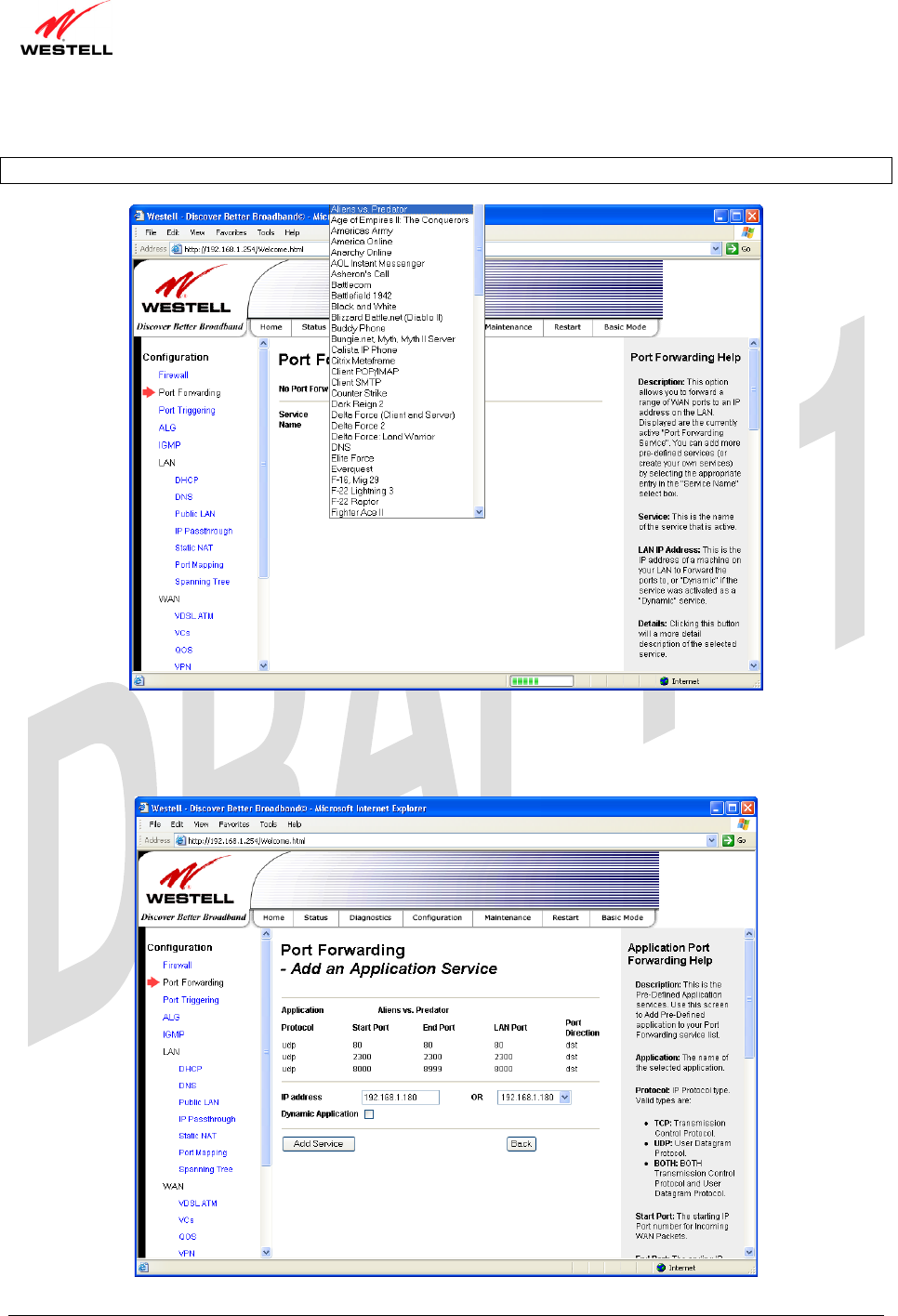
UltraLine II VDSL– Draft 1
030-300237 Rev. A
8/8/06
030-300237 Rev. A 40 August 2006
User Guide UltraLine II VDSL Gateway (Model 826010)
To set up port forwarding, select a service from the Service Name drop-down menu.
NOTE: You may add an unlimited numbers of services to your connection profile.
After you have selected a service name from the Service Name drop-down menu, the following Port Forwarding –
Add an Application Service screen will be displayed. Enter the appropriate IP address or machine name in the fields
provided and then click Add Service. Repeat these steps to add additional services to your profile.
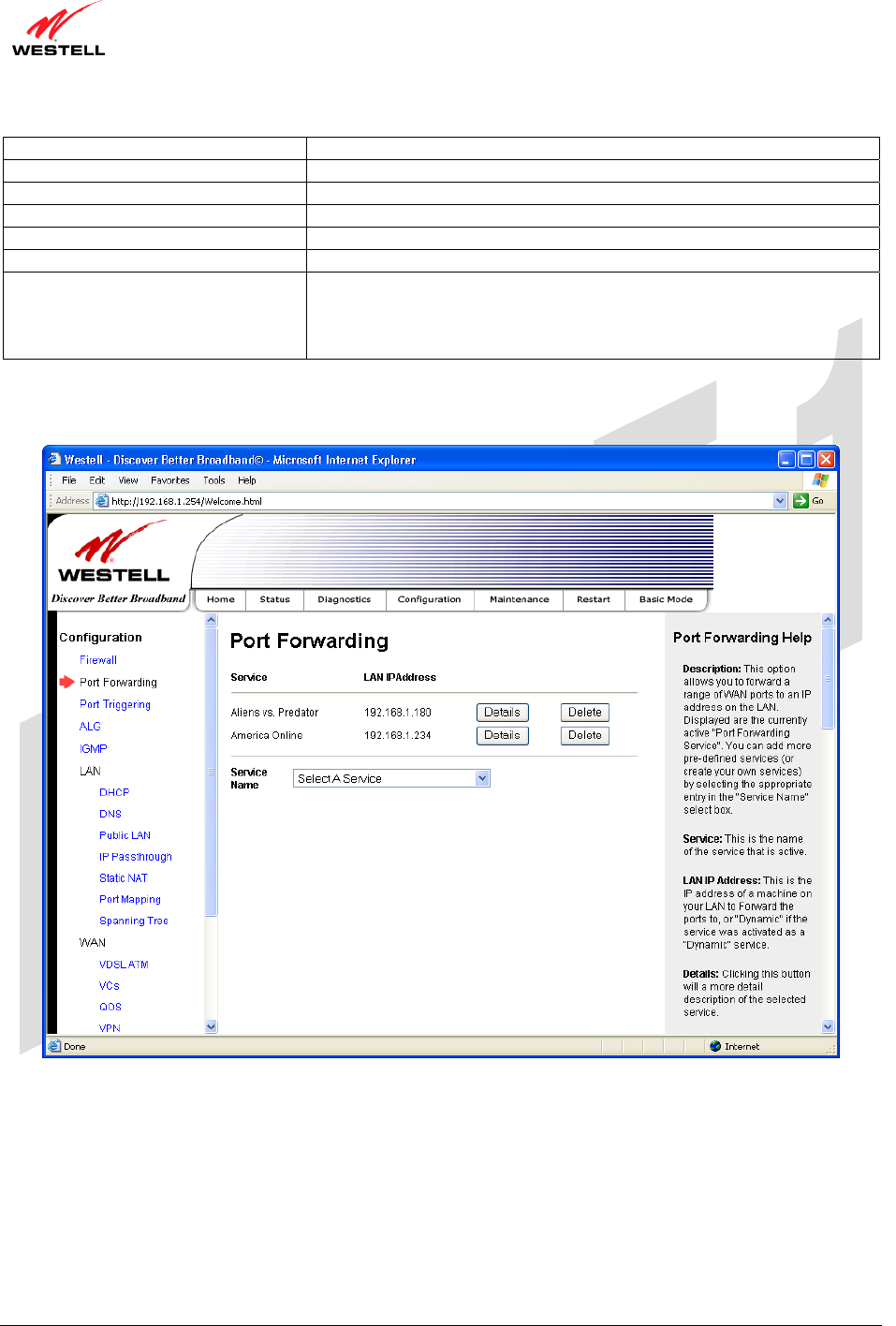
UltraLine II VDSL– Draft 1
030-300237 Rev. A
8/8/06
030-300237 Rev. A 41 August 2006
User Guide UltraLine II VDSL Gateway (Model 826010)
Application Protocol The IP Protocol type that is assigned to this service.
Start Port The start port that is assigned to the service
End Port The end port that is assigned to the service
LAN Port The LAN port that is assigned to the service.
Port Direction The traffic direction assigned to the service.
IP Address The LAN IP address or the machine name assigned to your service
Dynamic Application Factory Default = Disabled
If Enabled (box is checked), this will only allow outgoing connections
from any local PC.
If Disabled, packets will be forwarded to the designated local PC.
If you clicked Add Service, Port Forwarding will be updated and the following screen will be displayed. To view
the details of a service that you have added, click the Details button adjacent to the service you want to view.
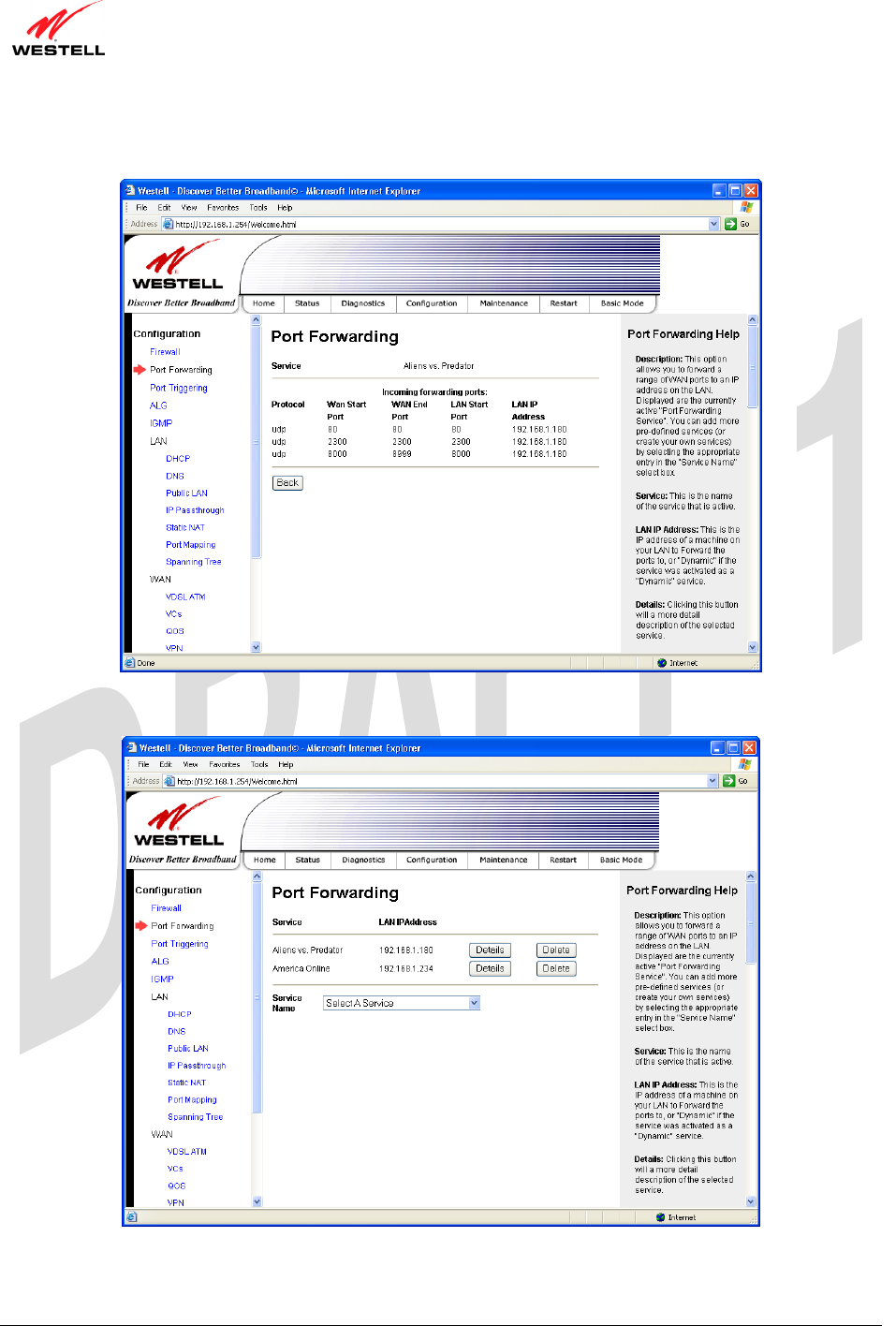
UltraLine II VDSL– Draft 1
030-300237 Rev. A
8/8/06
030-300237 Rev. A 42 August 2006
User Guide UltraLine II VDSL Gateway (Model 826010)
If you clicked the Details button, the following screen will be displayed. After viewing the details, click Back to
return to the preceding Port Forwarding screen.
To delete a service that you have added, click the Delete button adjacent to the service you want to remove.

UltraLine II VDSL– Draft 1
030-300237 Rev. A
8/8/06
030-300237 Rev. A 43 August 2006
User Guide UltraLine II VDSL Gateway (Model 826010)
If you clicked Delete in the preceding screen, a pop-up screen will prompt you to confirm your decision to delete the
selected service. Click OK in the pop-up screen; the service will be removed from the list of selected services. Click
Cancel if you do not want to delete the service.
If you clicked OK in the preceding pop-up screen, the following Port Forwarding screen will show that the service
has been deleted.

UltraLine II VDSL– Draft 1
030-300237 Rev. A
8/8/06
030-300237 Rev. A 44 August 2006
User Guide UltraLine II VDSL Gateway (Model 826010)
15.3 Port Triggering Configuration
The following screen will be displayed if you select Configuration > Port Triggering from the menu options. To
create a trigger port, click New.
If you clicked New, the following screen will be displayed. Select the desired options from the drop-down menus,
and then enter the appropriate values in the fields provided. Click Save to save your settings.
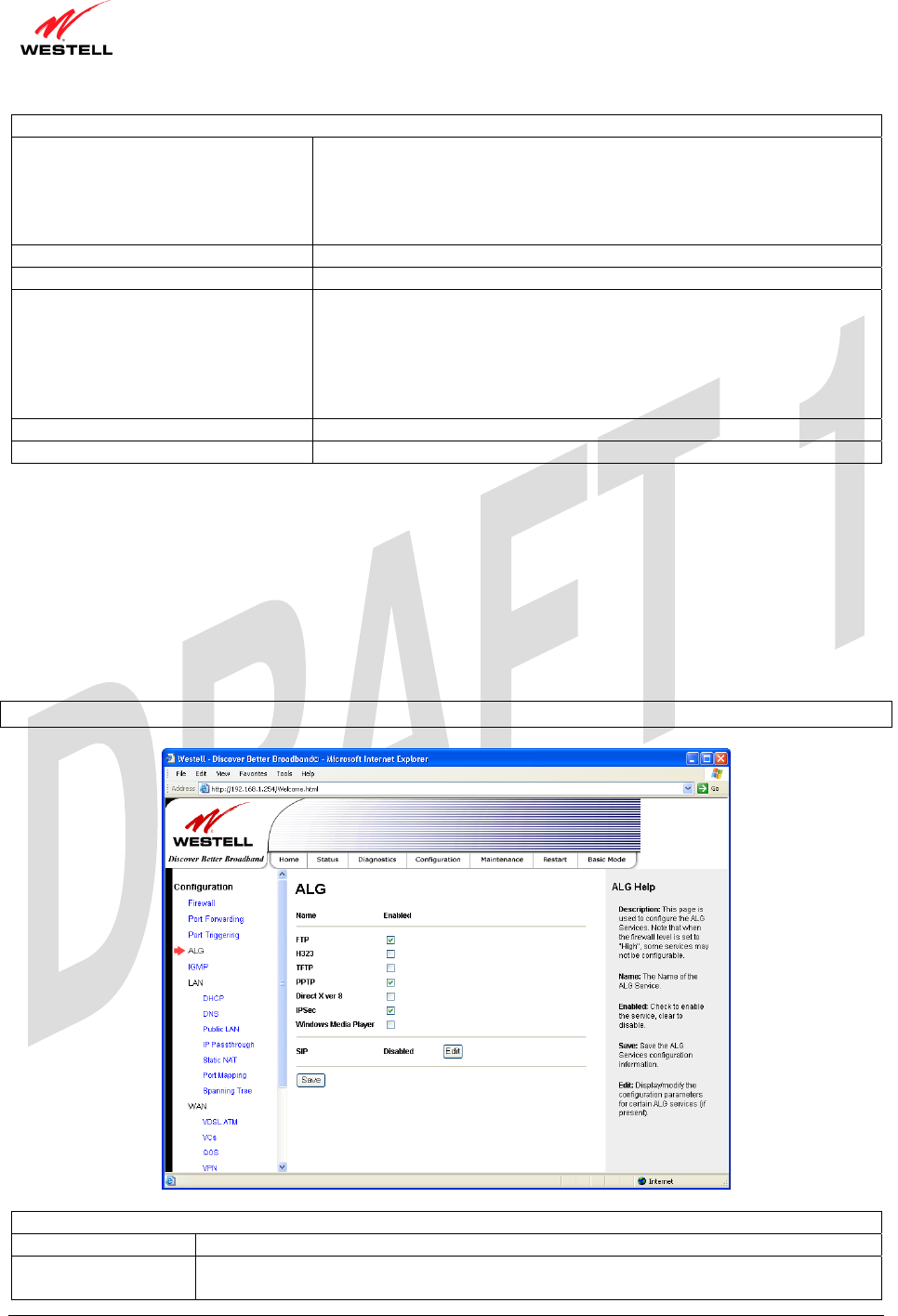
UltraLine II VDSL– Draft 1
030-300237 Rev. A
8/8/06
030-300237 Rev. A 45 August 2006
User Guide UltraLine II VDSL Gateway (Model 826010)
Port Triggering Configuration
Outgoing Protocol Factory Default = TCP
The outgoing protocol for the triggered ports.
Possible Responses:
TCP – Transmission Control Protocol
UDP – User Datagram Protocol
Outgoing Port Start The WAN-side TCP/UDP starting port
Outgoing Port End The WAN-side TCP/UDP ending port
Incoming Protocol Factory Default = TCP
The incoming protocol for the triggered ports.
Possible Responses:
TCP- Transmission Control Protocol
UDP- User Datagram Protocol
Both – TCP and UDP
Incoming Port Start The local LAN-side starting port.
Incoming Port End The local LAN-side ending port.
15.4 ALG Configuration
The following screen will be displayed if you select Configuration > ALG from the menu options. This screen
enables you to configure the application level gateway (ALG) services for your Gateway.
To enable ALG services, click the box of each service that you want to activate (a check mark will appear in the
box). Then, click Save to save the settings. To edit your SIP ALG settings, click Edit.
NOTE: When the firewall level is set to “High,” some services may not be configurable.
ALG
Name The name of the ALG service.
Enabled To enable the service, click the adjacent check box (a check mark will appear in the box).
To disable the service, click to uncheck the box.

UltraLine II VDSL– Draft 1
030-300237 Rev. A
8/8/06
030-300237 Rev. A 46 August 2006
User Guide UltraLine II VDSL Gateway (Model 826010)
If you clicked Edit, the following page will be displayed. To enable SIP ALG service configuration, click the box
labeled Enable (a check mark will appear in the box). Next, enter the desired values in the fields provided and click
Save to save your settings.
SIP ALG Service Configuration
Enabled Factory Default = Disabled
When enabled (box is checked), SIP ALG service will be activated.
If disabled, SIP ALG service will be deactivated.
SIP Port The SIP port to proxy.
RTP Port Low The lowest port for incoming RTP connections.
RTP Port High The highest port for incoming RTP connection. The highest port must be greater
than the lowest port.
RTP Timeout The number of seconds until a stream will timeout (in seconds).

UltraLine II VDSL– Draft 1
030-300237 Rev. A
8/8/06
030-300237 Rev. A 47 August 2006
User Guide UltraLine II VDSL Gateway (Model 826010)
15.5 IGMP Service
The following screen will be displayed if you select Configuration > IGMP from the menu options. This screen
enables you to configure the IGMP services for your Gateway. Enter the appropriate settings and then click Save
Settings to save the settings. To view the status of the settings, click Show Status.
IGMP Service
Internet Group Management Protocol (IGMP) enables you to configure IGMP services for your Gateway.
Enabled Factory Default = Enabled
When this box is checked, IGMP service will be activated.
To disable IGMP service, click to uncheck the box.
Use Secondary WAN Factory Default = Enabled
When this box is checked, the Gateway will use the secondary WAN interface for
Multicast traffic. This applies only when PPPoE is configured as the Primary
WAN protocol and the Secondary WAN is enabled when configuring PPPoE.
General Query Interval The Interval between general queries (30-180, in seconds).
Query Response Interval The maximum response time for general queries (1-10 in seconds).
LAN Robustness Variable The number of times to send a message (1-4) on the LAN, for reliability.
WAN Robustness Variable The number of times to leave a message (1-4) on the WAN, for reliability.
Leave Repeat Interval The interval between leave messages sent on a WAN (1-50, in tenths of a second).
Unsolicited Report Count The number of unsolicited member reports (1-4) sent on a WAN when first
joining the group.

UltraLine II VDSL– Draft 1
030-300237 Rev. A
8/8/06
030-300237 Rev. A 48 August 2006
User Guide UltraLine II VDSL Gateway (Model 826010)
Unsolicited Report Interval The interval between unsolicited reports on a WAN when first going a group (1-
100, in tenths of a second).
Last member Query Interval The interval between group-specific query messages sent in response to Leave
messages. This value is also used as the time-out for group-specific query
messages (1-50, in tenths of a second).
Multicast Filters
Filter Enabled Factory Default = Disable
When enabled (box is checked), Multicast Filter is activated.
When disabled, any requests from LAN devices for multicast content will be
allowed.
Range 1 and 2 When multicast filtering is enabled, you may configure up to two ranges of
prohibited multicast traffic. A filter address of zero inhibits that filter.
Address and Mask The address and mask for each multicast filter range describe the prohibited
multicast content. Note: Any address bits outside of the mask are ignored.
If you clicked Show Status in the preceding screen, the following screen will be displayed. This screen provides
details status of your IGMP service. After viewing this screen, click Back to return to the main IGMP screen.
IGMP Service
Internet Group Management Protocol (IGMP) enables you to configure IGMP services for your Gateway.
Enabled This field displays the status of the IGMP service. If IGMP has been enabled in
the main IGMP Service screen, this field will display Up.
Operational State This field will display Up only when IGMP Service has been enabled and the
WAN is Up.
Interface Count The number of LAN and WAN interfaces that are up.
Multicast Group Count The number of multicast groups that are being forwarded from the WAN to the
LAN interface.
Received/Transmitted The number of packets or bytes received from the WAN or transmitted to various

UltraLine II VDSL– Draft 1
030-300237 Rev. A
8/8/06
030-300237 Rev. A 49 August 2006
User Guide UltraLine II VDSL Gateway (Model 826010)
Packets/Bytes LAN interfaces. Note: These counts include all queries received from the WAN or
sent to a LAN interface, so the received counts may not match the transmitted
counts if the rate of queries is not the same for both interfaces. Also, if multicast
streams are gong to more than one LAN interface, comparing LAN and WAN
counts may be impossible due to possible overlap in the LAN interface counts
(i.e., two LAN interfaces with the same stream will double count).
15.6 LAN Configuration
This section explains how to configure your Gateway’s LAN settings.
15.6.1 DHCP for Private LAN
The following screen will be displayed if you select Configuration > LAN > DHCP from the menu options. This
screen allows you to control how the Gateway interacts with local devices to which it is connected.
NOTE: Westell recommends that you do not change these settings unless your service provider instructs you to do so.
To enable DHCP for Private LAN, do the following:
1. Click the Enable DHCP Server check box (a check mark will appear in the box). Note: By factory default
this box will already contain a check mark.
2. Enter the appropriate address values in the fields provided. (Refer to the following table for information
about the Private LAN settings.)
3. Enter the desired lease time values.
4. Click Save to save the settings.

UltraLine II VDSL– Draft 1
030-300237 Rev. A
8/8/06
030-300237 Rev. A 50 August 2006
User Guide UltraLine II VDSL Gateway (Model 826010)
DHCP Configuration for Private LAN
Enable DHCP Server Factory Default = Enable
This setting allows the Gateway to automatically assign IP addresses to local devices
connected on the LAN. Westell advises setting this to Enabled for the private LAN.
Note: When Enabled (box is checked), DHCP addresses will be saved into the Private
LAN configuration.
Possible Responses:
If this box is checked, the DHCP server will be turned On.
If this box is unchecked, the DHCP server will be turned Off.
Note: These addresses will be overwritten if the Internet Service Provider supports
dynamic setting of these values.
Modem IP Address The IP Address of the Gateway.
Subnet Mask The Subnet Mask of the Gateway.
Address Range
DHCP Start Address Factory Default = 192.168.1.1
This field displays the first IP address that the DHCP server will provide. The DHCP
Start Address must be within the Gateway’s IP subnet and lower than the DHCP End
Address. You may use any number from 0 to 254 in this address.
DHCP End Address Factory Default = 192.168.1.253
This field displays the last IP address that the DHCP server will provide. The DHCP
End Address must be within the Gateway’s IP subnet and higher than the DHCP Start
Address. You may use any number from 0 to 254 in this address.
DHCP Lease Time Factory Default = 01:00:00:00
Displays the amount of time the provided addresses will be valid, after which the
DHCP client will usually re-submit a request.
Note: DHCP Lease Time is displayed in the format (day:hour:min:sec). This value
must be greater than 10 seconds. (Hours must be between 0 and 23; Minutes must be
between 0 and 59; and Seconds must be between 0 and 59.)
If the settings you have entered in the DHCP for Private LAN screen are incorrect, the following warnings
messages may be displayed via pop-up screens. If this occurs, check the Private LAN settings.
Warning Message Check Public LAN DHCP Settings
Start Address is not part of the Subnet Check the value in the DHCP Start Address field
End Address is not part of the Subnet Check the value in the DHCP End Address field
End Address is below the Start Address Check the value in the DHCP End Address field
Lease time must be greater than 10 seconds Check the values in the DHCP Lease Time fields
Seconds must be between 0 and 59 Check the Seconds field at DHCP Lease Time
Minutes must be between 0 and 59 Check the Minutes field at DHCP Lease Time
Hours must be between 0 and 23 Check the Hours field at DHCP Lease Time